

Gabo Island Lighthouse
Heritage Management Plan
The Australian Maritime Safety Authority makes this heritage management plan under section 341S of the Environment Protection and Biodiversity Conservation Act 1999 (Cth) for Gabo Island Lighthouse.
5 September 2023
Mick Kinley
Chief Executive Officer
Copyright
© Australian Maritime Safety Authority
The Australian Maritime Safety Authority encourages the dissemination and exchange of information provided in this publication.
Except as otherwise specified, all material presented in this publication is provided under Creative Commons Attribution 4.0 International licence. This excludes:
- the Commonwealth Coat of Arms
- this department's logo
- content supplied by third parties.
The Creative Commons Attribution 4.0 International Licence is a standard form licence agreement that allows you to copy, distribute, transmit and adapt this publication provided that you attribute the work. The details of the version 4.0 of the licence are available on the Creative Commons website, as is the full legal code for that licence.
Third Party Copyright
Some material in this document, made available under the Creative Commons Licence framework, may be derived from material supplied by third parties. The Australian Maritime Safety Authority has made all reasonable efforts to identify content supplied by third parties using the following format ‘© [name of third party]’ or ‘Source: [name of third party]’. Permission may need to be obtained from third parties to re-use their material.
Acknowledgements
The Australian Maritime Safety Authority acknowledges the Traditional Custodians and other Aboriginal peoples of the region, their rich culture and spiritual connection to Country and Sea.
Contact
Comments or questions regarding this document should be addressed to:
The Australian Maritime Safety Authority,
Manager Asset Management and Preparedness,
PO Box 10790,
Adelaide Street, Brisbane QLD 4000
Phone: (02) 6279 5000 (switchboard)
Email: Heritage@amsa.gov.au
Website: www.amsa.gov.au
Attribution
Australian Maritime Safety Authority’s preference is that you attribute this publication (and any material sourced from it) using the following wording:
Source: Australian Maritime Safety Authority Gabo Island Lighthouse Heritage Management Plan – 2023
Front cover image
Figure 1. Gabo Island Lighthouse (© AMSA, 2021)
More information
For enquiries regarding copyright including requests to use material in a way that is beyond the scope of the terms of use that apply to it, please contact us through our website: www.amsa.gov.au
Table of Contents
Executive Summary
- Introduction
- Background and purpose
- Heritage management plan objectives
- Methodology
- Status
- Authorship
- Acknowledgements
- Language
- Previous reports
- Sources of information and images
2. Gabo Island Lightstation Site
2.1 Location
2.2 Setting and landscape
2.3 Lease
2.4 Access
2.5 Listings
3. History
3.1 General history of lighthouses in Australia
3.2 The Commonwealth Lighthouse Service
3.3 Gabo Island: a history
3.4 The first Gabo Island Lighthouse (1853-1862)
3.5 The second Gabo Island Lighthouse (1862-present)
3.6 Lighthouse keepers
3.7 Chronology of major events
3.8 Changes and conservation over time
3.9 Summary of current and former uses
3.10 Summary of past and present community associations
3.11 Unresolved questions or historical conflicts
3.12 Recommendations for further research
4. Fabric
4.1 Fabric register
4.2 Related objects or associated AMSA artefacts
4.3 Comparative analysis
5. Heritage significance
5.1 Commonwealth heritage list – Gabo Island Lighthouse
5.2 VIC State heritage register – Gabo Island Lighthouse
5.3 Condition and integrity of the Commonwealth heritage values
5.4 Gain and/or loss of heritage values.
6. Opportunities and constraints
6.1 Implications arising from significance
6.2 Framework: sensitivity to change
6.3 Statutory and legislative requirements
6.4 Operational requirements
6.5 Occupier needs
6.6 Proposals for change
6.7 Potential pressures
6.8 Process for decision-making
7. Conservation management principles and policies
8. Policy implementation plan
8.1 Plan and schedule
8.2 Monitoring and reporting
Appendices
Appendix 1. Glossary of heritage conservation terms
Appendix 2. Glossary of historic lighthouse terms relevant to Gabo Island Lighthouse
Appendix 3. Table demonstrating compliance to the EPBC Regulations
Appendix 4. Gabo Island current light details
Reference List
Endnotes
List of Figures
Figure 1. Gabo Island Lighthouse (© AMSA, 2021)
Figure 2. Planning process applied for heritage management (Source: ICOMOS Australia, 1999)
Figure 3. Location of Gabo Island within Australia (Imagery ©2021 NASA, TerraMetrics, Map Data ©2021 Google)
Figure 4. Location of Gabo Island Lighthouse south of Victorian-New South Wales border (Imagery ©2021 TerraMetrics, Map Data ©2021 Google)
Figure 5. Gabo Island and Lighthouse (Imagery ©2021 CNES/Airbus, Maxar Technologies, Map Data ©2021 Google)
Figure 6. View of keeper cottages and other buildings from Gabo Island lighthouse tower (© AMSA, 2019)
Figure 7. AMSA Map of Lease, 2017 (Source: Esri, DigitalGlobe, GeoEye, Earthstar Geographics, CNES/Airbus DS, USDA, USGS, AEX, Getmapping, Aerogrid, IGN, IGP, swisstopo, and the GIS User Community)
Figure 8. View of Gabo Island Lighthouse and windbreak wall (© AMSA, 2019)
Figure 9. Incandescent oil vapour lamp by Chance Brothers (Source: AMSA)
Figure 10. Dioptric lens on display at Narooma (Source: AMSA, 2011)
Figure 11. Dalén's system – sun valve, mixer and flasher (Source: AMSA)
Figure 12. Plan and section of a lantern with lamps and reflectors for a fixed light for Cape Howe, Bass Straits (Gabo Island Lighthouse: Working Plan), 1846. NAA: A9568, 6/4/2 (© Commonwealth of Australia, National Archives of Australia)
Figure 13. New lighthouse: Gabo Island, 1860. NAA: A9568, 6/4/12 (© Commonwealth of Australia, National Archives of Australia)
Figure 14. Lighthouse station – Gabo Island – Boundary Walls, Gates etc, 1884. NAA: A9568, 6/4/14 (© Commonwealth of Australia, National Archives of Australia)
Figure 15. Photograph of Gabo Island Lighthouse and keepers, 1978. NAA: AA6180, 25/7/78/9 (© Commonwealth of Australia, National Archives of Australia)
Figure 16. Montague Island Lighthouse, NSW (© AMSA, 2021)
Acronym List
List of acronyms utilised throughout this heritage management plan:
Acronym | Definition |
AGA | Gas Accumulator Company |
AMSA | Australian Maritime Safety Authority |
AMSG | Australian Maritime Systems Group |
AtoN | Aid to Navigation |
BBT | Barbier, Benard, et Turenne |
CHL | Commonwealth Heritage List |
DCCEEW | Department of Climate Change, Energy, the Environment and Water |
EPBC Act | Environment Protection and Biodiversity Conservation Act 1999 (Cth) |
EPBC Regulations | Environment Protection and Biodiversity Conservation Regulations 2000 (Cth) |
HMP | Heritage Management Plan |
IALA | International Association of Marine Aids to Navigation and Lighthouse Authorities |
LED | Light emitting diode |
NAA | National Archives of Australia |
NES | National Environmental Significance |
NLA | National Library of Australia |
RMS | Record Management System |
RNE | Register for the National Estate (non-statutory archive) |
Executive Summary
Built in 1862, Gabo Island Lighthouse is a historic site recognised by the Commonwealth and the State Government of Victoria. The lighthouse was placed on the Commonwealth Heritage List in 2004 and is recognised for its aesthetic prominence in the landscape, its technical stonemason craftsmanship, and its association with prominent designers of the mid-19th century. The lighthouse is also listed on the Victorian Heritage Database for the site’s intactness as a mid to late century lightstation, and its technical achievement regarding its stonemasonry, and external and internal fittings.
Constructed to replace the pre-existing 1853 timber tower, the lightstation is located on Gabo Island within Bass Strait, approximately 13.9 kilometres from the township of Mallacoota (Vic). Standing at a height of 47 metres, the circular dressed granite structure was originally fitted with a 1st Order Chance Bros 12’ diameter lantern and fixed lens.
Presently, the tower is fitted with a Tideland Nova-250 beacon operating on an automated mechanism as part of AMSA’s network of Aids to Navigation (AtoN). The equipment on-site is serviced by AMSA’s maintenance contractor who visits at least once each year. AMSA officers visit on an ad-hoc basis for auditing, project and community liaison purposes.
Parks Victoria maintain all other structures outside of the AMSA lease including the keeper’s cottages and various service buildings. Parks Victoria also serve as caretaker for the fauna and flora of the Island.
This heritage management plan concerns the lighthouse within the AMSA lease, however it also addresses the management of the surrounding land. The plan is intended to guide AMSA’s decisions and actions. AMSA has prepared this plan to integrate the heritage values of the lighthouse in accordance with the Environment Protection and Biodiversity Conservation Act 1999 (EPBC Act), and the Environment Protection and Biodiversity Conservation Regulations 2000 (EPBC Regulations).
Well-built and generally well-maintained, the lighthouse is in relatively good, stable condition. The policies and management guidelines set out in this heritage management plan strive to ensure that the Commonwealth heritage values of Gabo Island Lighthouse are recognised, maintained and preserved for future generations.

- Introduction
1.1 Background and purpose
The Australian Maritime Safety Authority (AMSA) is the Commonwealth agency responsible for coastal aids to navigation (AtoN). AMSA’s network includes Gabo Island Lighthouse built in 1862.
Section 341S of the Environment Protection and Biodiversity Conservation Act 1999 (Cth) (EPBC Act) requires AMSA to prepare a management plan for Gabo Island Lighthouse that addresses the matters prescribed in Schedules 7A and 7B of the Environment Protection and Biodiversity Conservation Regulations 2000 (Cth) (EPBC Regulations). The principal features of this management plan are:
- a description of the place, its heritage values, their condition and the method used to assess its significance
- an administrative management framework
- a description of any proposals for change
- an array of conservation policies that protect and manage the place
- an implementation plan
- ways the policies will be monitored and how the management plan will be reviewed.
AMSA has prepared this heritage management plan to guide the future conservation of the place. This plan provides the framework and basis for the conservation and best practice management of Gabo Island Lighthouse in recognition of its heritage values. The policies in this plan indicate the objectives for identification, protection, conservation and presentation of the commonwealth heritage values of the place. Figure 2 shows the basic planning process applied.

Figure 2. Planning process applied for heritage management (Source: Australia ICOMOS, 1999)
1.2 Heritage management plan objectives
The objectives of this heritage management plan are to:
- protect, conserve and manage the Commonwealth heritage values of the Gabo Island Lighthouse,
- interpret and promote the Commonwealth heritage values of the Gabo Island Lighthouse,
- manage use of the lighthouse,
- use best practice standards, including ongoing technical and community input, and apply best available knowledge and expertise when considering actions likely to have a substantial impact on Commonwealth heritage values.
In undertaking these objectives, this plan aims to:
- provide for the protection and conservation of the heritage values of the place while minimising any impacts on the environment by applying the relevant environmental management requirements in a manner consistent with Commonwealth heritage management principles.
- take into account the significance of the region as a cultural landscape occupied by Aboriginal people over many thousands of years.
- recognise that the site has been occupied by lease holders since the early 20th century.
- encourage site use that is compatible with the historical fabric, infrastructure and general environment.
- record and document maintenance works, and changes to the fabric in the Gabo Island Lighthouse fabric register.
The organisational planning cycle and associated budgeting process is used to confirm requirements, allocate funding and manage delivery of maintenance activities. Detailed planning for the AtoN network is managed through our internal planning processes.
An interactive map showing many of AMSA’s heritage sites, including Gabo Island, can be found at AMSA Heritage Lighthouses Interactive MapP0FP0F[1]PP.
1.3 Methodology
The methodology used in the preparation of this plan is consistent with the recommendations of The Burra Charter and with the requirements of Chapter 5, Part 15 Division 1A of the EPBC Act. In particular, the plan:
- details the history of the site based on information sourced from archival research, expert knowledge, and documentary resources.
- provides a description of the site based on information sourced from site inspection reports and fabric registers.
- details the Commonwealth heritage criteria satisfied by Gabo Island Lighthouse as set out by schedule 7A of the EPBC Regulations.
The criterion set out at Schedule 7A (h) (i-xiii) informed the development of the required policies for the management of the Gabo Island Lighthouse, in conjunction with input from the Department of Climate Change, Energy, the Environment and Water (DCCEEW) on best practice management.
Consultation
AMSA undertook consultation with Parks Victoria in May 2021. Parks Victoria provided site management information which was incorporated within the plan.
In preparation of the plan, AMSA initiated contact with the Nindi-Ngujarn Ngarigo Monero Aboriginal Corporation, and Bidwell-Maap Nations Aboriginal Corporation under direction from the Department of Premier & Cabinet VIC (Heritage Services, First Peoples - State Relations Group). As of yet, no responses have been received and future versions of the plan will include an update on this consultation progress.
The draft management plan was advertised in accordance with the EPBC Act and EPBC Regulations. On 7 March 2022 a notice was placed in The Australian newspaper publication which invited the general public to review the draft plan on AMSA’s website and provide feedback. Public consultation closed on 1 April 2022. No submissions were received.
A developed draft was submitted to the Federal Minister through the Heritage Branch of the Department of Climate Change, Energy, the Environment and Water (DCCEEW), and in that process the Minister’s delegate sought advice from the Australian Heritage Council. The plan was endorsed on 18 July 2023.
No updates or amendments have been made in this version of the plan.
1.4 Status
This plan has been adopted by AMSA in accordance with Schedule 7A (Management plans for Commonwealth Heritage places) and Schedule 7B (Commonwealth Heritage management principles) of the EPBC Regulations to guide the management of the place and for inclusion in the Federal Register of Legislative Instruments.
1.5 Authorship
This plan has been prepared by AMSA. At the initial time of publication, the Australian Maritime Systems Group (AMSG) was the contract maintenance provider for the Commonwealth Government’s AtoN network including Gabo Island Lighthouse.
1.6 Acknowledgements
AMSA acknowledges the professional assistance of the Department of Premier & Cabinet VIC for their assistance in preparation of the plan.
AMSA acknowledges the professional assistance of Parks Victoria for their contributions to the drafting process.
1.7 Language
For clarity and consistency, some words in this plan such as restoration, reconstruction and preservation, are used with the meanings defined in the Burra Charter[2]. (See Appendix 1 Glossary of heritage conservation terms).
Also see Appendix 2 Glossary of lighthouse terminology relevant to Gabo Island which sets out the technical terminology used in this plan.
1.8 Previous reports
- A Heritage Lighthouse Report was generated by Peter Marquis-Kyle in 2006 for AMSA.[3]
- A Heritage Asset Condition Report (4th Revision) was generated by AMSG in 2022 for AMSA.[4]
1.9 Sources of information and images
This plan has used a number of sources of information. This includes the National Archives of Australia (NAA), the National Library of Australia (NLA) and AMSA’s heritage collection.

2 Gabo Island Lightstation Site
2.1 Location
Gabo Island Lighthouse is located off the north-east coast of Victoria on Gabo Island, a 154 hectare landmass separated from the mainland by a 500 metre-wide channel. Situated approximately 8 kilometres south of the New South Wales/Victorian border, Gabo Island is approximately 13.9 kilometres from the township of Mallacoota.
Coordinates: 37° 34.0750' S, 149° 55.0096' E

Figure 3. Location of Gabo Island within Australia (Imagery ©2021 NASA, TerraMetrics, Map Data ©2021 Google)
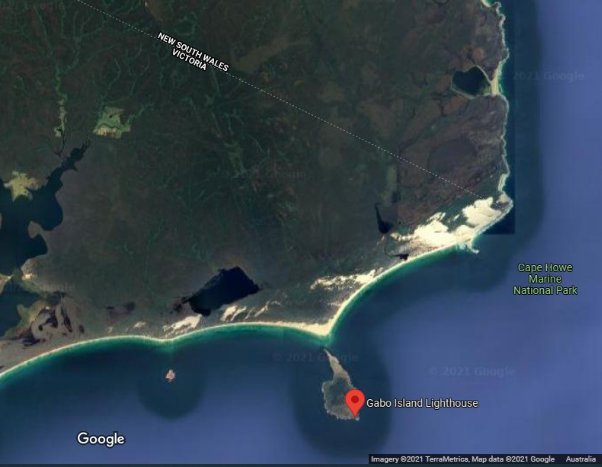
Figure 4. Location of Gabo Island Lighthouse south of Victorian-New South Wales border (Imagery ©2021 TerraMetrics, Map Data ©2021 Google)
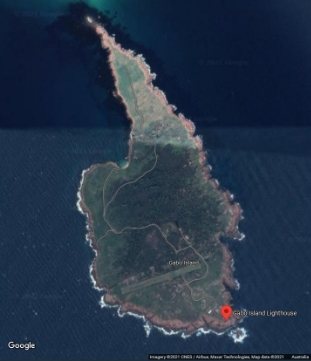
Figure 5. Gabo Island and Lighthouse (Imagery ©2021 CNES/Airbus, Maxar Technologies, Map Data ©2021 Google)
2.2 Setting and landscape
Standing at 52 metres above sea level, Gabo Island is a 2.4 kilometre long and 0.8 kilometre wide island. Aside from the lighthouse tower and keeper cottages, the following structures and notable features are located on the island:
- airfield
- jetty
- various sheds
- store room
- garage
- pump shed
- quarries
- gardens and fowl shed
- monument
- cemetery
- radar station
- original 1853 lighthouse remnant
- footings of WWII buildings
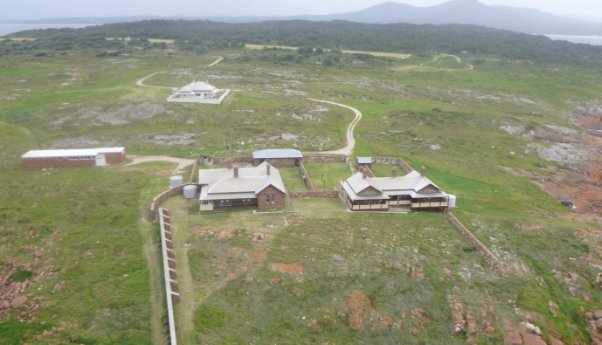
Figure 6. View of keeper cottages and other buildings from Gabo Island lighthouse tower (© AMSA, 2019)
Fauna and flora
Gabo Island is known to hold the largest little penguin colony in the world. Short-tailed shear-waters are also prevalent on the island, and the island is recognised by BirdLife International as an Important Bird Area.
Feral cats once presided over the island and impacted the bird colonies, however an eradication program from 1987-1991 successfully rid the island of feral cats.
2.3 Lease
AMSA leases Gabo Island Lighthouse from the Minister for Conservation and Environment (Victoria). The AMSA lease consists of two lots:
- Lot 2: 756.3m2
- Lot 3: 217m2
The current lease commenced on 1 December 1995 for a term of 21 years. Due to the popularity of the site, a tourist licence was established between AMSA and Parks Victoria commencing on 1 December 1995.
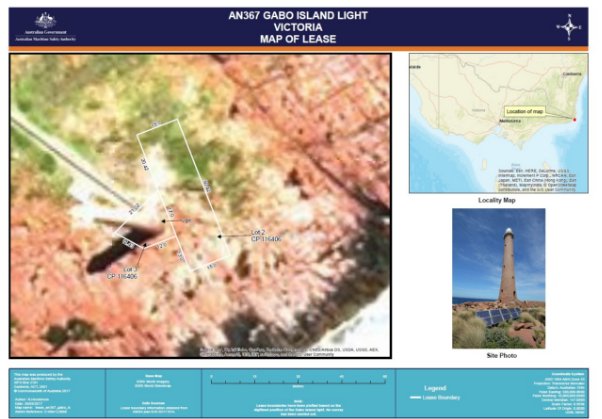
Figure 7. AMSA Map of Lease, 2017 (Source: Esri, DigitalGlobe, GeoEye, Earthstar Geographics, CNES/Airbus DS, USDA, USGS, AEX, Getmapping, Aerogrid, IGN, IGP, swisstopo, and the GIS User Community)
2.4 Access
Due to the island’s isolated location, the lighthouse is only accessible by authorised charter boat operators and fixed wing aircraft licenced with Parks Victoria. Access inside the lighthouse is restricted to authorised personnel and official tour groups only. 
Figure 8. View of Gabo Island Lighthouse and windbreak wall (© AMSA, 2019)
2.5 Listings
Gabo Island Lighthouse is included on the following heritage registers:
Register | ID |
Commonwealth Heritage List | 105379[5] |
Register of the National Estate | 4739[6] |
Victorian Heritage Register | H1843[7] |

3 History
3.1 General history of lighthouses in Australia
The first lighthouse to be constructed on Australian soil was Macquarie Lighthouse, located at the entrance to Port Jackson, NSW. First lit in 1818, the cost of the lighthouse was recovered through the introduction of a levy on shipping. This was instigated by Governor Lachlan Macquarie, who had ordered and named the light.
The following century oversaw the construction of hundreds of lighthouses around the country. Constructing and maintaining a lighthouse were costly ventures that often required the financial support of multiple colonies. However, they were deemed necessary aids in assisting the safety of mariners at sea. Lighthouses were firstly managed by the colony they lay within, with each colony developing their own style of lighthouse and operational system. Following Federation in 1901, which saw the various colonies unite under one Commonwealth government, lighthouse management was transferred from State hands to the Commonwealth Lighthouse Service.
Lamps and optics – an overview |
Lighthouse technology has altered drastically over the centuries. 18th century lighthouses were lit using parabolic mirrors and oil lamps. Documentation of early examples of parabolic mirrors in the United Kingdom, circa 1760, were documented as consisting of wood and lined with pieces of looking glass or plates of tin. As described by Searle, “When light hits a shiny surface, it is reflected at an angle equal to that at which it hit. With a light source is placed in the focal point of a parabolic reflector, the light rays are reflected parallel to one another, producing a concentrated beam”.[8]
In 1822, Augustin Fresnel invented the dioptric glass lens. By crafting concentric annular rings with a convex lens, Fresnel had discovered a method to reduce the amount of light absorbed by a lens. The Dioptric System was adopted quickly with Cordouran Lighthouse (France), fitted with the first dioptric lens in 1823. The majority of heritage-listed lighthouses in Australia house dioptric lenses made by others such as Chance Brothers (United Kingdom), Henry-LePaute (France), Barbier, Bernard & Turenne (BBT, France) and Svenska Aktiebolaget Gasaccumulator (AGA of Sweden). These lenses were made in a range of standard sizes, called orders—see Appendix 2. Glossary of lighthouse Terms relevant to Gabo Island Lighthouse.

Figure 9. Incandescent oil vapour lamp by Chance Brothers (Source: AMSA)
Figure 10. Dioptric lens on display at Narooma (Source: AMSA, 2011)
Early Australian lighthouses were originally fuelled by whale oil and burned in Argand lamps, and multiple wicks were required in order to create a large flame that could be observed from sea. By the 1850s, whale oil had been replaced by colza oil, which was in turn replaced by kerosene, a mineral oil.
In 1900, incandescent burners were introduced. This saw the burning of fuel inside an incandescent mantle which produced a brighter light with less fuel within a smaller volume. Light keepers were required to maintain pressure to the burner by manually pumping a handle as can be seen in Figure 9.
In 1912, Gustaf Dalén, a Swedish engineer, was awarded the Nobel Prize in physics for a series of inventions relating to acetylene-powered navigation lights. Dalén’s system included the sun valve, the mixer, the flasher, and the cylinder containing compressed acetylene. Due to their efficiency and reliability, Dalén’s inventions led to the gradual de-staffing of lighthouses. Acetylene was quickly adopted by the Commonwealth Lighthouse Service from 1915 onwards.

Figure 11. Dalén's system – sun valve, mixer and flasher (Source: AMSA)
Large dioptric lenses, such as that shown in Figure 10, gradually decreased in popularity due to cost and the move towards unmanned automatic lighthouses. By the early 1900s, Australia had stopped ordering these lenses with the last installed at Eclipse Island in Western Australia in 1927. Smaller Fresnel lenses continued to be produced and installed until the 1970s when plastic lanterns, still utilising Fresnel’s technology, were favoured instead. Acetylene remained in use until it was finally phased out in the 1990s.
In current day, Australian lighthouses are lit and extinguished automatically using mains power, diesel generators, and solar-voltaic systems.
3.2 The Commonwealth Lighthouse Service
When the Australian colonies federated in 1901, they decided that the new Commonwealth government would be responsible for coastal lighthouses—that is, major lights used by vessels travelling from port to port—but not the minor lights used for navigation within harbours and rivers. There was a delay before this new arrangement came into effect. Existing lights continued to be operated by the states.
Since 1915, various Commonwealth departments have managed lighthouses. AMSA, established under the Australian Maritime Safety Authority Act 1990 (Cth), is now responsible for operating Commonwealth lighthouses and other aids to navigation, along with its other functions.
3.3 Gabo Island: a history
Aboriginal history
Gabo Island has an extensive history that stretches far beyond the arrival of Europeans, and the island is of extreme significance. Further consultation is required with Traditional Custodians.
Early European history
The 1770 expedition to Australia, led by naval explorer Captain James Cook, first made landfall on 19 April 1770 near modern-day Point Hicks, Victoria. That same day, Cook recorded in his journal:
Friday 20th[9]. – In the P.M. and most part of the night had a fresh Gale Westerly, with Squalls, attended with Showers of rain. In the A.M. had the Wind at S.W., with Severe weather, At 1 P.M. saw 3 Water Spouts at once; 2 were between us and the Shore, and one at some distance on our Larboard Quarter. At 6, shortened sail, and brought too for the Night, having 56 fathoms fine sandy bottom. The Northernmost land in sight bore N. by E. (half) E., and a small island lying close to a point on the Main bore W., distant 2 Leagues. This point I have named Cape Howe; it may be known by the Trending of the Coast which is N. on one Side and S.W. on the other. Lat 37°28’ S.; Long 210°3’W. It may be known by some round hills upon the main just within it.[10]
The ‘small island lying close’ identified by Cook would later be known as Gabo Island.
Later expeditions recorded the prevalence of seals in Bass Strait which led to an explosion of sealing in the region. Although no conclusive evidence has been found to suggest Gabo Island and its harbour were used as a sealing base, it was used as a base for whaling in the early 19th century. Dr Imlay’s whaling establishment operated on Gabo Island for a period of time, however by 1846 all that remained of the station was three deserted huts.[11]
3.4 The first Gabo Island Lighthouse (1853-1862)
By the 1840s, it was determined by the various Australian colonies that Bass Strait required lighting. The Strait was traversed frequently by shipping, and its treacherous waters had claimed many vessels and lives over the course of the early 19th century. No coastal lighthouse had been constructed in Australia since Macquarie Light in 1818, the country’s first lighthouse, meaning “there was no systematic approach to the lighting of the long and dangerous coast of Australia”.[12] The Cape Howe region was presented to the colonies in 1841 as a possible site for a lighthouse. Sir John Franklin, Governor of Van Diemen’s Land (Tasmania), addressed the matter with Sir George Gipps, Governor for New South Wales, who in turn agreed that “a Light on Cape Howe would also be most desirable”.[13]
No further action was taken until 1845 when the Select Committee of the Legislative Council of New South Wales reiterated these statements, and in 1846 Gabo Island was surveyed and officially recommended by Charles J Tyers, Commissioner of Crown Lands in District Gipps Land. Tyers detailed that the firm sandy soil found at the island’s highest point at the centre of the landmass was ideal for the construction of a lighthouse.[14]
Tenders were called in June 1846 and a Mr John Morris was accepted as contractor. Excavations commenced on the island where it was assumed a foundation would be located approximately 2.5 metres below the surface. However, 12 months later, workers had excavated to a depth of 20 meters and no solid foundation had been found. With costs now expected to exceed the funds available, debates ensued on whether it was better to choose a different site. Work on the Island eventually came to a standstill as additional arguments sprouted over government finances and which colony Gabo Island would belong to following the separation of New South Wales and Victoria in 1850.[15]
While these arguments ensued, tragedy struck. Monument City, the first steamer to cross the Pacific, was returning from Melbourne on 15 May 1853 when it ran aground on Tullaberga Island a mere five kilometres west of Gabo Island. 33 lives were lost and it was agreed across the board that such an incident would not have occurred had a light been established. In the days following the tragedy, it was declared Gabo Island lay within the colony of Victoria and that a temporary lighthouse was to be built ‘as soon as possible’ with costs split between both colonies.[16]

Figure 12. Plan and section of a lantern with lamps and reflectors for a fixed light for Cape Howe, Bass Straits (Gabo Island Lighthouse: Working Plan), 1846. NAA: A9568, 6/4/2 (© Commonwealth of Australia, National Archives of Australia)
By September 1853, a prefabricated wooden tower and a Wilkins lantern ordered some time ago and left in storage, were shipped to Gabo Island and erected at the original site excavated. On 28 November 1853, the tower was lit for the first time. The Cornwall Chronicle described the tower as:
a skeleton timber erection, painted White; the roof and framing of the Lantern painted Red: and the Ventilating Ball painted Yellow. It stands nearly at the centre of the Island, about three-quarters of a mile from its southern point, upon a sand-hill 157ft 6in. above the sea. The centre of the Light is 21 ft 6in. above the sand…
The Light is a fixed White Light of the First Class, consisting of 24 Catoptric Lamps in 2 ranges, illuminating the whole horizon. The Light is eclipsed by a small range of sand-hills from S. 15° E. to S. 4° W. (in all 19 degrees), to a distance averaging about 2 miles out to sea.
It is estimated that the Light can be seen 20 miles distance in clear weather.[17]
The lighthouse was christened ‘Flinders Light’, after navigator and cartographer Matthew Flinders, and remained lit for nine years before a permanent light was eventually built.
3.5 The second Gabo Island Lighthouse (1862-present)
By 1859, Flinders Light had fallen into disrepair and calls for the construction of a permanent tower to replace the 1853 timber frame were brought to the forefront. Like the existing light, the cost of the new tower was to be split between the New South Wales and Victorian colonies.
Design
The new lighthouse was designed as a “tapering column of smooth red granite topped with a new pattern Chance Brothers lantern containing a fixed light”.[18] This design was chosen due to the high amount of durable, red granite quarried from the island. By October 1859, the Chance Bros. lantern had been ordered. It was decided the lighthouse should be built on the south-eastern shore of the Island instead of replacing the timber structure in the centre.
Records differ in crediting the design of the new Gabo Island Lighthouse. Some attribute the design to William Wilkinson Wardell who was charged with public works in Victoria at the time, while others determine the design was created by Charles Maplestone who was Clerk of Works in Melbourne.[19] A majority agree that while Wardell did visit Gabo Island in 1860, Charles Maplestone was responsible for the design, with Maplestone writing in a letter:
I shall soon be putting in hand a lighthouse of Red Granite 150 feet high – I have got drawings in hand, and have sent home for the lantern and apparatus.[20]

 Figure 13. New lighthouse: Gabo Island, 1860. NAA: A9568, 6/4/12 (© Commonwealth of Australia, National Archives of Australia)
Figure 13. New lighthouse: Gabo Island, 1860. NAA: A9568, 6/4/12 (© Commonwealth of Australia, National Archives of Australia)
 Figure 14.Lighthouse station – Gabo Island – Boundary Walls, Gates etc, 1884. NAA: A9568, 6/4/14 (© Commonwealth of Australia, National Archives of Australia)
Figure 14.Lighthouse station – Gabo Island – Boundary Walls, Gates etc, 1884. NAA: A9568, 6/4/14 (© Commonwealth of Australia, National Archives of Australia)
Construction
Tenders were called in July 1860 and awarded to Melbourne contractor Robert Huckson for £14,950. Construction started shortly after, however issues arose within months of commencement with masons complaining of poor provisions and threatening to leave the island. It was found that Huckson had established a ‘Truck System’ on the island where he “had compelled them [the workers] to enter into a new contract by which the wages were higher, but by which they were to purchase all their provisions from him at an exorbitant price”.[21] By 1862, Huckson was declared bankrupt by reason of ‘heavy losses in a contract for erecting lighthouse at Gabo Island, and pressure of creditors’ liabilities’.[22]
The contract was handed over to Alexander Cairns and Henry Mills on 20 February 1862, and by May of that same year it was reported that the lighthouse was complete.[23] On 20 August, Flinders Light was officially extinguished and the new Gabo Island Lighthouse was lit for the first time.
Equipment when built
Upon completion, Gabo Island Lighthouse stood as a 47 metre, circular dressed granite structure. The tower supported a Chance Bros. 12’ diameter lantern and 920 millimetre 6 panel 315° 1st Order fixed lens with 45° catoptric reflector. The light was recorded as having an intensity of 7000 c.d. and a range of 20 miles in good, clear weather.[24]
The tower was accompanied by a new head keeper’s cottage and two assistant keeper cottages. Although the Flinders Light lantern was removed, the wooden structure remained on the island for a number of years as well as the former keepers’ cottages.
3.6 Lighthouse keeping
The lighthouse was originally operated by a head keeper, two assistant keepers and their respective families. Although inhabitants were secluded from the mainland, at various times throughout the years Gabo Island would be filled with a number of workmen quarrying the island’s granite, effectively breaking the isolation.[25]
Telegraphic communications were established on the Island in 1870 with a line reaching across the channel on posts and eventually run along the seabed. A telegraph office, erected beside the assistant keeper cottages, was originally of timber design until 1887 when a mass concrete residence and office was designed and constructed in its place.[26]
Throughout the duration of World War II, naval personnel were stationed on Gabo Island in corrugated iron huts, and air force personnel manned a radar station erected on the site of Flinders Light.[27]
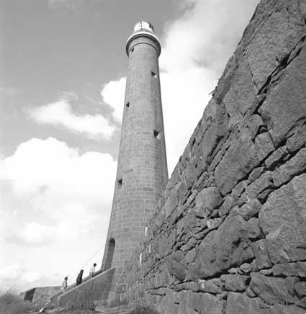
Figure 15. Photograph of Gabo Island Lighthouse and keepers, 1978. NAA: A6180, 25/7/78/9 (© Commonwealth of Australia, National Archives of Australia)
There is no concise date on when the keepers were removed from the Island and the site de-staffed.
3.7 Chronology of major events
The following table details the major events to have occurred on Gabo Island from 1853 to present.
Date | Event |
28 November 1853 | Flinders Light on Gabo Island lit for first time. |
1860 | Construction begins on permanent Gabo Island Lighthouse. |
20 August 1962 | Flinders Light extinguished and Gabo Island Lighthouse lit for first time. |
1870 | Telegraphic communications established on Gabo Island.[28] |
1887 | Timber telegraph office upgraded to mass concrete residence and office.[29] |
1895 | Extreme weather washes away 228 feet of the stone wall on Gabo Island.[30] |
18 July 1928 | Assistant lighthouse keeper, Percival Field dies aboard rescue ship after falling 80 feet from flag mast at lightstation.[31] |
May 1930 | A ‘serious operation’ is performed on Mrs Broderick, a keepers’ wife, on-site at the station. The destroyer HMAS Anzac takes Mrs Broderick to the mainland to recover.[32] |
1938-1945 | Naval units stationed on Gabo Island throughout World War II, and air force personnel man radar station on site.[33] |
1962 | Original balcony balustrade replaced. |
1993 | Light automated. |
3.8 Changes and conservation over time
The following section details the changes and conservation efforts to have been carried out at Gabo Island Lighthouse since its construction in 1862.
The Brewis Report
Commander CRW Brewis, retired naval surveyor, was commissioned in 1911 by the Commonwealth Government to report on the condition of existing lights and to recommend any additional ones. Brewis visited every lighthouse in Australia between June and December 1912, and produced a series of reports published in their final form in March 1913. These reports were the basis for future decisions made in relation to each individual lighthouses and provide a snapshot of the Gabo Island Lightstation in the early 20th century.
Recommendations made by Brewis for Gabo Island Lighthouse included: the installation of an occulting screen, clockwork mechanism, and 85 mm incandescent mantle, the discontinuation of the red auxiliary light, alteration of the fog signal, the provision of an efficient Morse lamp, and the removal of the danger light platform and lightning conductor.[34]
Gabo Island Light. (20 miles from Green Cape.) Lat. 37° 34’ S., Long. 149° 55’ E., Chart No. 3169.- Established 1862. Last altered, 1909. Lloyd’s Signal Station. Character.- Main Light.- One white, with red sectors. Catadioptric. Fixed. Candle-power – white, 15,000 c.p.; red, 3,750 c.p. Illuminant, vaporized kerosene; 55 mm. incandescent mantle. Circular granite tower, 156 feet. Height of focal plane, 179 feet. Auxiliary Danger Light.- Red; fixed; exhibited from base of same tower as main light. Visibility.- Main Light.- Red, through an arc of 20 degrees, from 204° (S. 14° W. Mag.) to 224° (S. 34° W. Mag.); white, through an arc of 136 degrees, from 224° (S. 34° W. Mag.) to 55° (N. 45° E. Mag.); red through an arc of 39 degrees, from 55° (N. 45° E. Mag.) to 94° (N. 84° E. Mag.), and obscured elsewhere. Visible, in clear weather – white, for a distance of about 20 nautical miles; red, 10 nautical miles. Auxiliary Danger Light.- Visible, in clear weather, 3 miles seaward. Fog Signal.- Two explosive rockets fired in quick succession every ten minutes. Optical Apparatus.- Chance Bros., 1860. Catadioptric. Fixed lens. Focal radius, 36 inches. Six panels with one catoptric mirror. Condition and State of Efficacy.- The tower , lantern, and optical apparatus are in good condition and serviceable. The dwellings were repaired in 1911. The light requires to be given a distinctive character. The period of the fog signal is too long for the requirements of modern navigation. The auxiliary red danger light is shown to warn a vessel of her close approach to the shore. In thick weather it may not be visible. (Caution in Light List.) Three light-keepers are stationed here. Communication.- Telephone to Eden, 9 a.m. to 8 p.m. Visited quarterly by Government steamer. Coastal steamers fortnightly, weather permitting; contract under notice to expire. Morse lamp at station, but of low power. Fogs.- Not frequent; experienced chiefly in December and January. Soundings.- The soundings on the chart in this locality are of a complete and suitable nature, and the only legitimate and unerring guide to the safety of a vessel in this vicinity is the use of the lead, giving the navigator a sure indication of his distance from the shore. A mariner who relies on sighting the auxiliary red light (already rendered worthless by the Caution in the Light List) as a means of keeping his vessel out of danger and neglects to use the lead, undoubtedly trusts to a false security, and hazards the safety of his vessel and the lives of those on board.
Recommended.- (a) An occulting screen actuated by clock-work mechanism be inserted, converting the light to white, with red sectors, occulting every 12 seconds, thus – light, nine seconds; eclipse, three seconds. (b) An 85 mm. incandescent mantle, illuminant vaporized kerosene, be installed, increasing the power of the white light to be approximately 30,000 c.p., and the red sectors to 7,000 c.p. (c) The auxiliary red danger light be discontinued. (This was discontinued 1st January, 1913) (d) The period of the fog signal be altered to two explosive rockets fired in quick succession every five minutes, and the present supply of rockets (1,000) proportionately increased. (This has been carried out, January, 1913.) (e) Platform leading to danger light be removed. It is out of repair and not reliable. (f) Lighting conductor be overhauled. (g) Efficient Morse lamp be provided.
|
Alterations to the light
The following table details the changes made to the Gabo Island light since its exhibition in 1862.
Date | Alteration |
1862 | Chance Bros 12’ dia. lantern and 920 mm 6 panel 315° first order fixed lens with 45° catoptric reflector. Intensity: 7,000 c.d. |
10 July 1894 | 5th Order red auxiliary light installed at base of tower. |
1 Jan 1913 | Auxiliary light discontinued. |
2 July 1913 | Occulting shutter and clockwork installed 85 mm IOV burner Intensity: White 15,000 c.d. Red 3,750 c.d. |
1917 | Automatic acetylene with red and white sectors Intensity: White 13,000 c.d. Red 5,000 c.d. |
1934-35 | Conversion to electric with triple diesel generators. First Order lens replaced with Chance Bros 4th Order 3 panel lens. Fixed red light installed above main light. Intensity: White 750,000-927,000 c.d. [35] Red 12,000 c.d. |
25 Feb 1992 | Light converted to solar. 4th Order lens replaced with FA251 beacon. Intensity: 30,000 c.d. |
May 2006 | FA251 beacon replaced with Vega VRB-25 beacon. Intensity: 24,816 c.d. |
2020 | Vega VRB-25 beacon replaced with Tideland Nova-250 beacon. |
Recent conservation works
The following table details recent conservation works carried out on the lighthouse by AMSA and its contractors.
Date | Works completed |
2012 |
|
2019 |
|
3.9 Summary of current and former uses
From its construction in 1862, Gabo Island Lighthouse has been used as a marine AtoN for mariners at sea. Its AtoN capability remains its primary use.
The former lightkeeper’s quarters are now used to house Parks Victoria rangers carrying out caretaking duties on the island.
3.10 Summary of past and present community associations
Aboriginal associations
Further consultation is required with Traditional Custodians. AMSA will maintain correspondence with First Peoples - State Relations Group (Department of Premier & Cabinet, VIC) and encourage facilitation of stakeholder consultation via Parks Victoria.
Local, national and international associations
Gabo Island is considered a significant site of Victorian and Australian history. The island and lightstation maintain strong familial associations due to the lighthouse’s extensive history as a manned site.
As a recognised habitat for various faunal colonies, Gabo Island is associated locally, nationally and internationally with wildlife conservation.
3.11 Unresolved questions or historical conflicts
There exists a lack of information in some areas of the lighthouse’s history, such as the exact date the site was de-staffed. Research of this topic did not provide a specific year keepers were removed from the island. Widespread automation and de-staffing in Australian lighthouses occurred from 1975 onwards, and in an 1983 report ‘Lighthouses: do we keep the keepers?’ it was recommended Gabo Island Lighthouse be reduced to two staff.[36] It can only be presumed that the lighthouse was de-staffed sometime around 1993 when the site was automated.
It is also unclear what the intensity of the light became when the 1st order lens was replaced in 1934-1935. Searle determines that the new light had an intensity of 927,000 c.d. while newspaper reports of the time determined it to have 750,000 c.d.[37]
3.12 Recommendations for further research
Recommendations for further research will be listed here in future versions of the plan.

4 Fabric
4.1 Fabric register
The cultural significance of the lighthouse resides in its fabric, and in its intangible aspects, such as the meanings people ascribe to it, and the connections to other places and things. The survival of its cultural value depends on a well-informed understanding of what is significant, and on clear thinking about the consequences of change. The Burra Charter sets out good practice for conserving cultural significance.
Below, each part of the lighthouse is listed and the description, condition and significance of each part is discussed. Criterion listed under ‘Heritage Significance’ refer to the criterion satisfied within the specific Commonwealth heritage listing (see section 5.1).
(All images in sub-sections 4.1 and 4.2 - Source: AMSA)
Lighthouse feature: Lantern roof


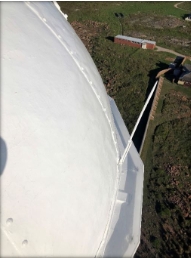

© AMSA 2020
Description and condition
Part-spherical dome of copper sheets lapped and screwed to ribs.
- Ribs – Not visible, but the pattern of screws indicate radial ribs.
- Inner skin – Copper sheets lapped and screwed to ribs.
- Ventilator – Ball type with wind vane attached.
- Wind vane – Attached to the top of the ventilator. Fixed, does not turn with the wind.
- Lightning conductor – Vertical pole on roof, with three spikes at top, and two braces to roof. Six vertical spikes attached near the gutter.
- Gutter – Polygonal fabricated gutter attached to ring of cast iron pieces bolted together.
Finish | painted |
Condition | intact and sound |
Significance | high |
Integrity | high |
Maintenance | keep in service, prepare and repaint at normal intervals |
Rectification works | none |
Heritage significance: High
The lantern roof contributes to the aesthetic value of the lighthouse within its setting (criterion e).
The lantern roof is an original feature of a lighthouse designed by an influential figure in Victoria’s architectural field (criterion h).
Lighthouse feature: Lantern glazing

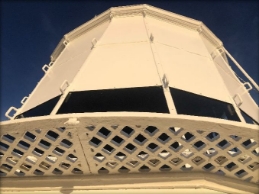
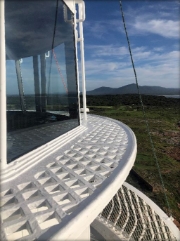
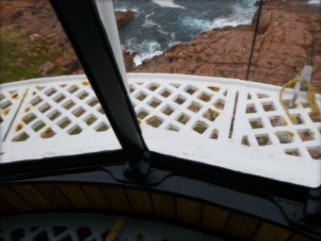
© AMSA 2020
Description and condition
Polygonal in form, with 16 sides.
- Panes – Flat trapezoidal glass, three tiers. Two upper tiers blanked off with fibrous-cement sheet, except for one pane of clear glass on the top tier, presumably for the auxiliary light.
- Astragals – Chance Bros vertical and horizontal astragals of triangular section, bolted to gutter ring at top, and to lantern base below.
- Ladder rail – Attached to gutter.
- Handholds – Three on each vertical astragal, fixed to cover strips.
Finish | astragals and glazing strips: painted |
Condition | intact and sound |
Significance | high |
Integrity | high |
Maintenance | keep in service, reglaze as necessary, prepare and repaint at normal intervals |
Rectification works | none |
Heritage significance: High
The lantern glazing contributes to the aesthetic value of the lighthouse within its setting (criterion e).
The lantern glazing is an original feature of a lighthouse designed by an influential figure in Victoria’s architectural field (criterion h).
Lighthouse feature: Auxiliary light platform

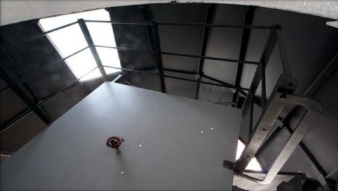
© AMSA 2020
Description and condition
1935 square platform framed with rolled steel channel joists and floored with steel plate, standing on rolled steel angle columns on the lantern floor. Around the platform is a balustrade of steel pipe rails and steel angle stanchions. Access is by fixed steel ladder from the interior catwalk.
Finish | painted |
Condition | intact and sound |
Significance | moderate |
Integrity | high |
Maintenance | prepare and repaint at normal intervals |
Rectification works | none |
Heritage significance: Moderate
The auxiliary light platform is an important feature in the lighthouse’s history.
Lighthouse feature: Internal catwalk

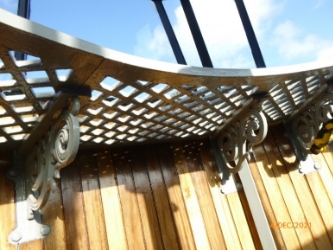
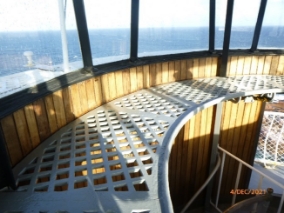 © AMSA 2021
© AMSA 2021
Description and condition
Cast iron lattice floor panels supported on openwork cast iron brackets bolted to the lantern base.
- Ladder – Fixed winding stair with cast iron treads/risers. Varnished moulded timber handrail on wrought iron balusters.
Finish | ladder handrail: varnished other parts: painted |
Condition | sound |
Significance | high |
Integrity | high |
Maintenance | keep in service, prepare and repaint at normal intervals |
Rectification works | none |
Heritage significance: High
The internal catwalk is an original feature of a lighthouse designed by an influential figure in Victoria’s architectural field (criterion h).
Lighthouse feature: External catwalk

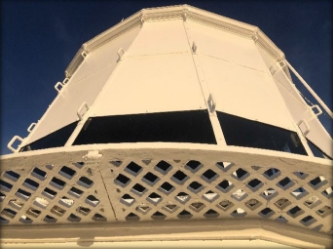 © AMSA 2020
© AMSA 2020
Description and condition
Cast iron lattice floor panels attached to the lantern base, without supporting brackets.
- Handrail – none.
Finish | painted |
Condition | intact and sound |
Significance | high |
Integrity | high |
Maintenance | keep in service, prepare and repaint at normal intervals |
Rectification works | none |
Heritage significance: High
The external catwalk contributes to the aesthetic value of the lighthouse within its setting (criterion e).
The external catwalk is an original feature of a lighthouse designed by an influential figure in Victoria’s architectural field (criterion h).
Lighthouse feature: Lantern base

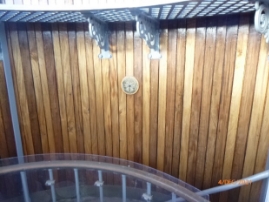

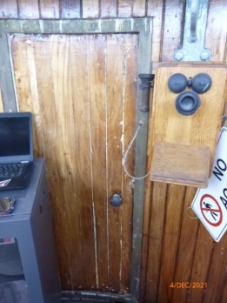 © AMSA 2021
© AMSA 2021
Description and condition
1862 Chance Bros, irregular 12-sided polygonal prism in form, with alternating long and short faces. Panels of cast iron bolted together with flanged joints. Decorative relief pattern on outside – diamond pattern in centre, border around each face.
- Internal lining – timber vertical tongue-and-groove boards with beaded joints.
- Vents – round air inlet in the middle of exterior of each panel (sealed off). Corresponding circular openings below the internal catwalk (each closed off with plywood disk).
- Doors – two Chance Bros cast iron doors on opposite sides of the lantern. Both have timber boarded linings to match the lantern base. One door is sealed closed and has a steel patch applied to exterior bottom. The other door is hung on copper alloy hinges and secured with a recent cast strong-back, stud and hand wheel.
Finish | internal timber lining: varnished other parts: painted |
Condition | intact and sound |
Significance | high |
Integrity | high |
Maintenance | keep in service, prepare and repaint at normal intervals |
Rectification works | none |
Heritage significance: High
The lantern base contributes to the aesthetic value of the lighthouse within its setting (criterion e).
The lantern base is an original feature of a lighthouse designed by an influential figure in Victoria’s architectural field (criterion h).
Lighthouse feature: Lantern floor

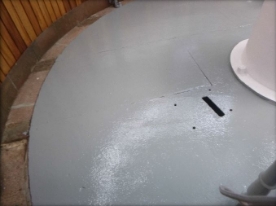
© AMSA 2020
Description and condition
Iron plate floor set flush with the top of the tower wall (which is visible between the lantern base and the edge of the iron floor), screwed to rolled iron T-beams set into the tower wall stonework.
Finish | painted |
Condition | intact and sound |
Significance | high |
Integrity | high |
Maintenance | keep in service, prepare and repaint at normal intervals |
Rectification works | none |
Heritage significance: High
The lantern floor is an original feature of a lighthouse designed by an influential figure in Victoria’s architectural field (criterion h).
Lighthouse feature: Beacon
 © AMSA 2021
© AMSA 2021
Description and condition
Tideland Nova-250 standalone LED lantern.
Condition | intact and sound |
Significance | low |
Integrity | high |
Maintenance | keep in service |
Rectification works | none |
Heritage significance: Low
Lighthouse feature: Pedestal
 © AMSA 2021
© AMSA 2021
Description and condition
1935 cast iron pedestal, with pipe column extension and aluminium adapter plate to attach the beacon.
Condition | intact and sound |
Significance | moderate |
Integrity | medium |
Maintenance | keep in service, prepare and repaint pedestal at normal intervals |
Rectification works | none |
Heritage significance: Low
Lighthouse feature: Balcony floor

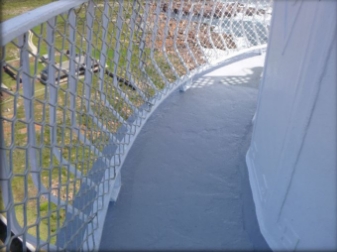 © AMSA 2020
© AMSA 2020
Description and condition
1862 stone slab floor, supported by the top of the tower wall and its cornice.
- Racon – from 1992; Tideland Seabeacon racon, mounted outside the balcony balustrade on bracket bolted to the balcony floor.
Finish | painted |
Condition | intact and sound |
Significance | balcony floor: high racon: low |
Integrity | high |
Maintenance | keep in service, maintenance joint seals, prepare and repaint at normal intervals |
Rectification works | none |
Heritage significance: High
The balcony floor is an original feature of a lighthouse designed by an influential figure in Victoria’s architectural field (criterion h).
Lighthouse feature: Balcony balustrade
 © AMSA 2021
© AMSA 2021
Description and condition
1962 welded mild steel balustrade with top and bottom rails of rectangular section joined by square section balusters. The balustrade is made in sections, bolted together, and bolted to steel feet attached to the edge of the balcony floor. Aluminium expanded metal mesh attached to inside of balusters.
Finish | aluminium mesh: bare anodised other parts: painted |
Condition | intact and sound |
Significance | moderate |
Integrity | high |
Maintenance | keep in service, prepare and repaint at normal intervals |
Rectification works | none |
Heritage significance: Moderate
The balcony balustrade is an important feature of a lighthouse designed by an influential figure in Victoria’s architectural field (criterion h).
Lighthouse feature: Walls

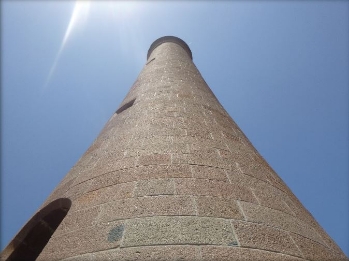
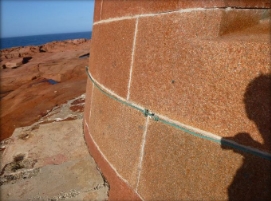

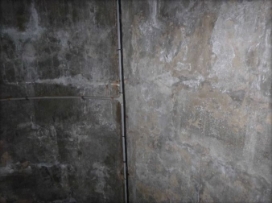 © AMSA 2020
© AMSA 2020
Description and condition
1862 walls of tooled granite, built with the internal face plumb so that the internal volume is of constant diameter.
Finish | exterior surface: bare stone interior surface: cement rendered and unpainted |
Condition | intact and sound |
Significance | high |
Integrity | high |
Maintenance | keep in service, monitor condition of pointing and stonework |
Rectification works | none |
Heritage significance: High
The walls contribute to the aesthetic value of the lighthouse within its setting (criterion e).
The walls exemplifies the exquisite stonemason craftsmanship employed at Gabo Island Lighthouse (criterion f).
The walls are an original feature of a lighthouse designed by an influential figure in Victoria’s architectural field (criterion h).
Lighthouse feature: Windows

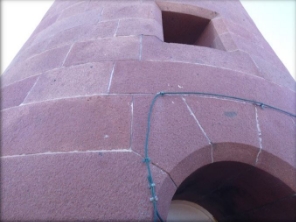
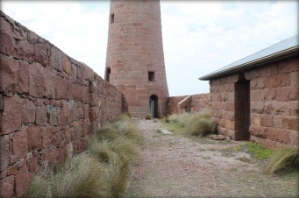
 © AMSA 2021
© AMSA 2021
Description and condition
Fixed glazed timber window sashes in timber frames. The sashes are fixed by means of bolts and wing nuts accessible from the inside.
Finish | frames and sashes: painted glass: clear |
Condition | intact and sound |
Significance | high |
Integrity | high |
Maintenance | keep in service, prepare and repaint at normal intervals |
Rectification works | none |
Heritage significance: High
The windows contribute to the aesthetic value of the lighthouse within its setting (criterion e).
The windows are original features of a lighthouse designed by an influential figure in Victoria’s architectural field (criterion h).
Lighthouse feature: Door
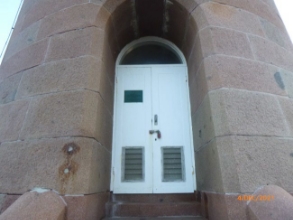
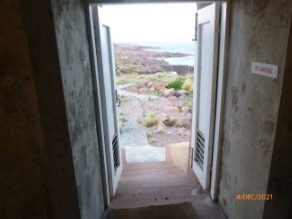
© AMSA 2021
Description and condition
Timber double doors to the main entrance (upper entrance floor) and the store entrance (ground entrance floor).
- Main door – recent pair of timber framed and sheeted doors with rebated meeting styles, hung in recent timber frame with arched head, transom, and fixed glazed fanlight. Each door leaf has a panel of fixed metal louvres inset in the bottom. One leaf secured with interior bolts top and bottom, the other with mortice lock and pad bolt.
- Store door – recent pair of timber framed and sheeted doors with rebated meeting styles, hung in recent timber frame with arched head, transom, and solid panel over. One leaf secured with interior bolt at top, the other with exterior pad bolt.
Finish | painted |
Condition | intact and sound |
Significance | moderate |
Integrity | high |
Maintenance | keep in service, prepare and repaint at normal intervals |
Rectification works | none |
Heritage significance: Moderate
The doors are replicas of an original feature of a lighthouse designed by an influential figure in Victoria’s architectural field (criterion h).
Lighthouse feature: Intermediate floors

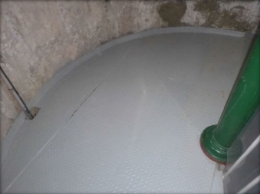 © AMSA 2020
© AMSA 2020
Description and condition
Six 1862 intermediate half-floors, of original iron plate mixed with some portions of recent steel chequer plate, carried on rolled iron beams built into the stone tower walls. Central cast iron column support.
- Handrails – iron handrails to match stairs, with cast iron sockets attached to floor framing. Clear acrylic sheeting is attached to the balustrade with U-bolts, to close the gaps between stanchions and raise the height of the balustrade.
Finish | painted |
Condition | one of the upper landings has a crack across near the stair other locations: some corrosion along wall with some gaps otherwise intact and sound |
Significance | high |
Integrity | high |
Maintenance | keep in service, prepare and repaint at normal intervals |
Rectification works | Investigate and perform repair to stabilize cracked landing |
Heritage significance: High
The intermediate floors are original features of a lighthouse designed by an influential figure in Victoria’s architectural field (criterion h).
Lighthouse feature: Upper entrance floor
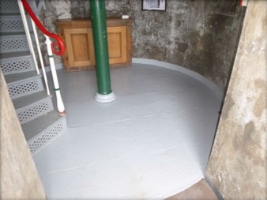
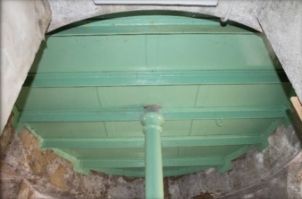
© AMSA 2020
Description and condition
This the entrance floor, one storey above ground, reached by the external entrance stair.
Recent steel chequer plate on original rolled iron T-beam built into the tower walls. Central cast iron column.
Finish | painted |
Condition | intact and sound |
Significance | high |
Integrity | high |
Maintenance | keep in service, prepare and repaint at normal intervals |
Rectification works | none |
Heritage significance: High
The upper entrance floor is an original feature of a lighthouse designed by an influential figure in Victoria’s architectural field (criterion h).
Lighthouse feature: Stairs
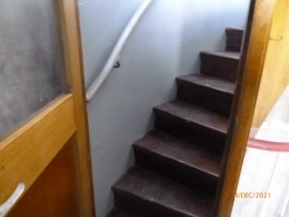

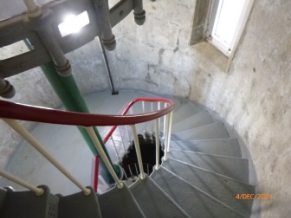 © AMSA 2021
© AMSA 2021
Description and condition
1978-1988 reconstruction of 1862 geometric stair with cast iron treads and risers bolted to the tower wall, with original handrails. Each flight is broken in the middle by a short landing carried on a cast iron bracket bolted to the tower wall.
- Handrails – 1862 tubular handrail and wrought iron stanchions fixed to the open side of the stair, and to intermediate floors.
- Topmost flight – the flight below the lantern floor has timber treads and risers, and is enclosed by a curved timber boarded wall and recent glazed framed door. Recent aluminium handrail.
Finish | timber parts: varnished other parts: painted |
Condition | intact and sound |
Significance | stairs: moderate handrail: high |
Integrity | high |
Maintenance | keep in service, prepare and repaint at normal intervals |
Rectification works | none |
Heritage significance: High
The stairs are a replica of the original stairs designed by an influential figure in Victoria’s architectural field (criterion h).
The handrails are an original feature of a lighthouse designed by an influential figure in Victoria’s architectural field (criterion h).
Lighthouse feature: Basement entrance floor
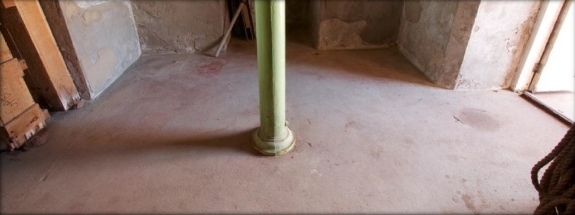

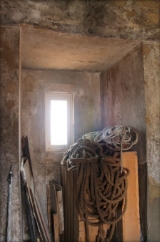 © AMSA 2020
© AMSA 2020
Description and condition
This is the floor of the ground level store room, accessible only through a separate door in the base of the tower.
1862 stone floor with concrete topping.
Finish | bare concrete |
Condition | intact and sound |
Significance | high |
Integrity | high |
Maintenance | none |
Rectification works | none |
Heritage significance: High
The basement entrance floor is an original feature of a lighthouse designed by an influential figure in Victoria’s architectural field (criterion h).
Lighthouse feature: Entrance stair
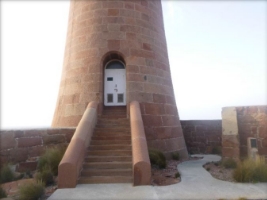

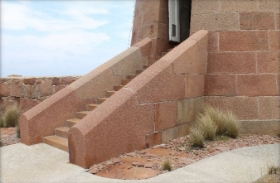

© AMSA 2020
Description and condition
1862 granite steps with solid balustrade walls with rounded tops.
Finish | bare stone |
Condition | intact and sound |
Significance | high |
Integrity | high |
Maintenance | keep in service, monitor condition of pointing and stonework |
Rectification works | none |
Heritage significance: High
The entrance stair contributes to the aesthetic value of the lighthouse within its setting (criterion e).
The entrance stair exemplifies the exquisite stonemason craftsmanship employed at Gabo Island Lighthouse (criterion f).
The entrance stair is an original feature of a feature designed by an influential figure in Victoria’s architectural field (criterion h).

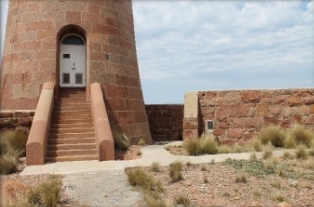
 Lighthouse feature: Paths
Lighthouse feature: Paths
© AMSA 2020
Description and condition
Recent concrete path leading to the store door and the bottom of the entrance stair.
Finish | trowelled bare concrete |
Condition | sound |
Significance | low |
Integrity | medium |
Maintenance | none |
Rectification works | none |
Heritage significance: Low
Lighthouse feature: Windbreak walls
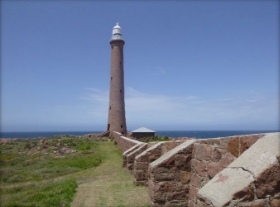
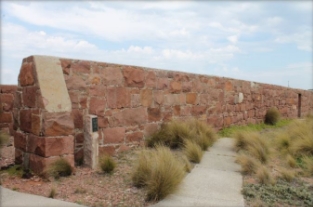
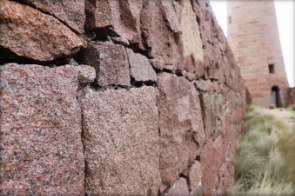
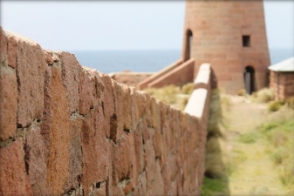
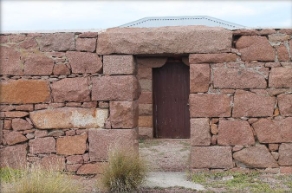

© AMSA 2020
Description and condition
1862 windbreak walls of un-coursed granite rubble, abutting the base of the tower. The walls have a cement mortar coping applied to their tops.
Finish | bare stone |
Condition | stable |
Significance | high |
Integrity | high |
Maintenance | keep in service, monitor condition of pointing and stonework |
Rectification works | none |
Heritage significance: High
The windbreak wall contributes to the aesthetic value of the lighthouse within its setting (criterion e).
The windbreak wall is an original feature of a lighthouse designed by an influential figure in Victoria’s architectural field (criterion h).
4.2 Related object and associated AMSA artefact
There are no AMSA artefacts stored on-site at Gabo Island Lighthouse.
Parks Victoria holds a collection of artefacts related to Gabo Island which are displayed at the lightstation.[38]
4.3 Comparative analysis
Gabo Island Lighthouse somewhat resembles Montague Island Lighthouse in design and history. Designed by renowned colonial architect James Barnet and constructed in 1881, Montague Island Lighthouse is located approximately 150 kilometres north of Gabo Island along the coast of New South Wales. Both island lighthouses had their granite quarried on-site and assembled to form tapering tower walls. Chance Bros. & Co. was responsible for the original 1st order lenses installed at Montague and Gabo.
Similarly, the original contractor assigned to construct Montague Island Lighthouse was forced to give up the contract after controversial difficulties and delays, as was the case with Robert Huckson for the Gabo Island Lighthouse.
Gabo Island Lighthouse’s unique upper entrance floor and basement design resembles Table Cape Lighthouse (Tas) and Eddystone Point Lighthouse (Tas). All three lighthouses have upper entrance floors accessed via external stairs, and basements accessed on the ground floor where battery equipment is stored.

Figure 16. Montague Island Lighthouse, NSW (© AMSA, 2021)
Figure 16. Montague Island Lighthouse, NSW (© AMSA, 2021)
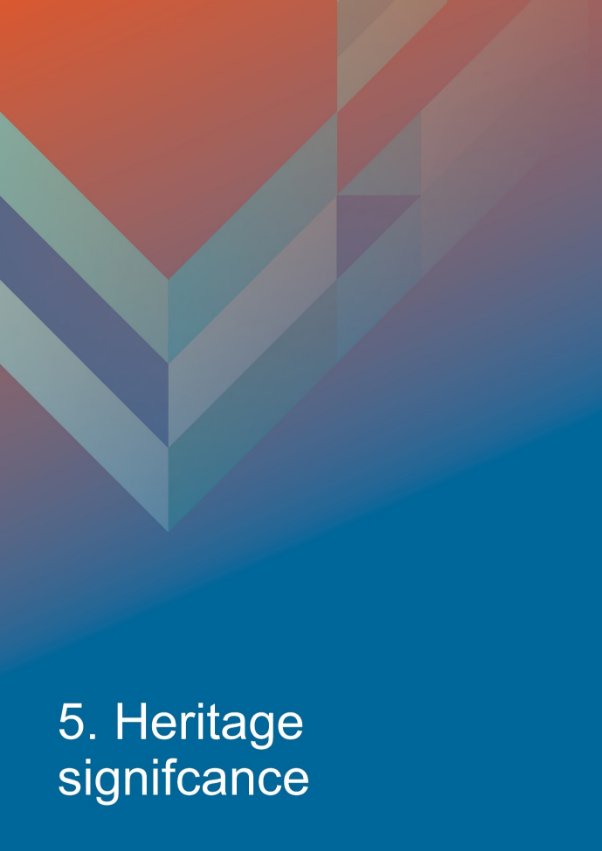
5 Heritage significance
5.1 Commonwealth heritage list – Gabo Island Lighthouse
The following information is taken directly from the Commonwealth Heritage listing for Gabo Island Lighthouse (Place ID: 105379).[39]
Commonwealth statement of significance
The Gabo Island Lighthouse, built in 1862, is architecturally significant as an elegant and impressive red granite structure designed by WW Wardell of the Public Works Department of Victoria. Its design features, such as the parabolic curved profile, were replicated at all subsequent manned lighthouses in Victoria (Criterion H.1).
The lighthouse is significant as a dominant feature in the landscape of Gabo Island and surrounding region. The lack of development on the island and the nearby mainland area has maintained much of the physical and visual context of the lightstation (Criterion E.1).
The Gabo Island Lighthouse is significant as an outstanding example of the stonemason's craft. The structure utilizes the red granite available on the isolated site. The smooth-faced stone finish to the lighthouse is a departure from the more common practice of building towers in either rock-faced stonework or rendered rubble (Criterion F.1).
Commonwealth heritage criteria
There are nine criteria for inclusion in the Commonwealth Heritage List – meeting any one of these is sufficient for listing a place. These criteria are similar to those used in other Commonwealth, state and local heritage legislation, although thresholds differ. In the following sections, Gabo Island Lighthouse is discussed in relation to each of the criteria as based on the site’s current Commonwealth Heritage Listing (Place ID: 105379)
Criterion | Relevant attributes identified | Explanation |
Criterion E – Aesthetic characteristics
This criterion is satisfied by places that have significant heritage value because of [their] importance in exhibiting a particular aesthetic characteristic value by a community or cultural group. | The form of the lighthouse in its landscape setting | The lighthouse is significant as a dominant feature in the landscape of Gabo Island and surrounding region. The lack of development on the island and the nearby mainland area has maintained much of the physical and visual context of the lightstation. |
Criterion F – Technical achievement
This criterion is satisfied by places that have significant heritage value because of [their] importance in demonstrating a high degree of creative or technical achievement at a particular period.
| The tower’s high quality stonemasonry | The Gabo Island Lighthouse is significant as an outstanding example of the stonemason's craft. The structure utilizes the red granite available on the isolated site. The smooth-faced stone finish to the lighthouse is a departure from the more common practice of building towers in either rock-faced stonework or rendered rubble. |
Criterion H) – Significant people
This criterion is satisfied by places that have significant heritage value because of [their] special association with the life or works of a person, or group of persons, of importance in Australia’s natural or cultural history.
| The architectural form, red granite finish and parabolic curved profile | The Gabo Island Lighthouse, built in 1862, is architecturally significant as an elegant and impressive red granite structure designed by WW Wardell of the Public Works Department of Victoria. Its design features, such as the parabolic curved profile, were replicated at all subsequent manned lighthouses in Victoria. |
5.2 VIC State Heritage Register – Gabo Island Lighthouse
The following information is taken directly from the Victorian State Heritage register listing of Gabo Island Lighthouse (Place ID: H1843).[40]
VIC heritage statement of significance
Lightstation group of 1853-62 consisting of a 150 foot tower; head keeper’s and assistant keepers' quarters; two ancillary buildings and enclosing and connecting walls, all constructed of locally quarried red granite, together with a detached former signal station of rendered masonry added in 1887.
The striking colour of the granite is enhanced by the exacting workmanship of the dressed masonry. Whilst later infilling of verandahs and sundry additional buildings are excluded, the recent use of red brick is a sympathetic alternative to the local granite.
The cast iron spiral staircase in the tower, with its central column supporting the landings is typically detailed. The cast iron external lantern gallery is unusual in having no supporting brackets, and the cast blocking plates are decorated with ribbon borders in relief. The balustrade of the lower balcony is of later design and is excluded.
The interior of the lantern room is finely detailed and well maintained with a bracketed cast iron lantern walkway and polished brass handrails and fittings.
VIC State heritage criteria
The following table details the state heritage criterion assessed for each registered site. In regards, to Gabo Island Lightstation, no explanation is provided of which criterion the site meets in the Victorian Heritage Database.
Criterion |
Criterion A The historical importance, association with or relationship to Victoria's history of the place or object.
|
Criterion B The importance of a place or object in demonstrating rarity or uniqueness.
|
Criterion C The place or object's potential to educate, illustrate or provide further scientific investigation in relation to Victoria's cultural heritage.
|
Criterion D The importance of a place or object in exhibiting the principal characteristics or the representative nature of a place or object as part of a class or type of places or objects.
|
Criterion E The importance of the place or object in exhibiting good design or aesthetic characteristics and/or in exhibiting a richness, diversity or unusual integration of features.
|
Criterion F The importance of the place or object in demonstrating or being associated with scientific or technical innovations or achievements.
|
Criterion G The importance of the place or object in demonstrating social or cultural associations.
|
Criterion H Any other matter which the Council considers relevant to the determination of cultural heritage significance.
|
These heritage values, identified and explained in the Commonwealth Heritage List and the State Heritage Register, will form the basis of the management of Gabo Island Lighthouse. In the event of necessary works, all criteria will be consulted to inform best practice management of the values associated with the lighthouse. (See Section 7. Conservation management policies for further information on strategies to conserve heritage values of the Gabo Island Lighthouse)
5.3 Condition and integrity of the Commonwealth heritage values
A heritage monitoring program was implemented in 2016. Each site is visited and reviewed every two years to evaluate the heritage fabric and values of the site. Assessment of the condition and integrity of lighthouse's values are derived from the latest available Heritage Asset Condition Report produced by AMSA’s maintenance contractor.
‘Condition’ is measured on a Good – Fair – Poor scale and incorporates the current condition of the specific value. Integrity is measured on a High – Medium – Low scale which incorporates the value’s intactness.
Gabo Island Lighthouse’s Commonwealth heritage values and its associated attributes maintain good condition and high-medium integrity. The integrity is somewhat diminished due to the removal of the original internal stair and balcony balustrades.
Criteria | Values (including attributes) | Condition | Integrity |
Criterion E) Aesthetic value
| The lighthouse is significant as a dominant feature in the landscape of Gabo Island and surrounding region. The lack of development on the island and the nearby mainland area has maintained much of the physical and visual context of the lightstation.
The form of the lighthouse in its landscape setting. | Good | High-medium |
Criterion F) Technical achievement
| The Gabo Island Lighthouse is significant as an outstanding example of the stonemason's craft. The structure utilizes the red granite available on the isolated site. The smooth-faced stone finish to the lighthouse is a departure from the more common practice of building towers in either rock-faced stonework or rendered rubble.
The tower’s high quality stonemasonry. | Good | High |
Criterion H) Significant people
| The Gabo Island Lighthouse, built in 1862, is architecturally significant as an elegant and impressive red granite structure designed by WW Wardell of the Public Works Department of Victoria. Its design features, such as the parabolic curved profile, were replicated at all subsequent manned lighthouses in Victoria.
The architectural form, red granite finish and parabolic curved profile. | Good | High-medium |
5.4 Gain and/or loss of heritage values
Evidence for the potential gain or loss of heritage values will be documented within this section.
Criterion H should be updated to reflect Charles Maplestone’s role in designing Gabo Island Lighthouse. Historical evidence demonstrates that although W W Wardell was at some point involved in the planning the site, Maplestone was responsible for the design plans used to construct the lighthouse.[41]
Updating its historical accuracy should not diminish this heritage value. Charles Maplestone was a significant figure of his time as Clerk of Works in Melbourne. Maplestone was responsible for a number of Victorian coastal and harbour lights including Cape Schanck, Cape Otway, Gabo Island and Wilsons Promontory which are recognised for their historical, technical and aesthetic values on State and Commonwealth heritage registers. Maplestone contributed to the built history of Victoria and his designs still stand in the 21st century.
AMSA proposes Criterion H should be read as:
The Gabo Island Lighthouse, built in 1862, is architecturally significant as an elegant and impressive red granite structure designed by Charles Maplestone, Clerk of Works in Melbourne. Its design features, such as the parabolic curved profile, were replicated at all subsequent manned lighthouses in Victoria.

6 Opportunities and constraints
6.1 Implications arising from significance
The Commonwealth statement of significance (section 5.1 above) demonstrates Gabo Island Lighthouse is a place of considerable heritage value due to its contribution to the development of coastal navigation along the Victorian coastline.
The implication arising from this assessment is that key aspects of the place should be conserved to retain this significance. The key features requiring conservation include:
- Continued use of the lighthouse as an AtoN
- Architectural quality of the building
- Interior spaces and features, which are notable for their design, details and/or their original lighthouse function. These include:
- Basement floor
- Upper entrance floor
- Intermediate floors
- Lantern room and internal catwalk
- Internal stairs
- External spaces and features, which are notable for their design, details, and/or their original lighthouse function. These include:
- Dome and glazing
- Balcony
- Tower walls
- Doors and windows
- External stair
- Windbreak wall
Referral and approvals of action
The EPBC Act requires approval from the Minister for the Environment for all actions likely to have a significant impact on matters of National Environmental Significance (NES). The Act provides that the following actions require approval of the Minister:
- Actions taken on Commonwealth land which are likely to have a significant impact on the environment.
- Actions taken outside Commonwealth land which are likely to have a significant impact on the environment on Commonwealth land.
- Actions taken by the Australian Government or its agencies which are likely to have a significant impact on the environment anywhere.
The definition of ‘environment’ in the EPBC Act and EPBC Regulations includes the cultural heritage values of places.
Heritage strategy
If an Australian Government agency owns or controls one or more places with Commonwealth heritage values, it must prepare a heritage strategy within two years from the first time they own or control a heritage place (section 341ZA).
A heritage strategy is a written document that integrates heritage conservation and management within an agency’s overall property planning and management framework. Its purpose is to help an agency manage and report on the steps it has taken to protect and conserve the commonwealth heritage values of the properties under its ownership or control. The heritage strategy for AMSA’s AtoN assets was completed and approved by the Commonwealth Minister for the Environment in 2018 and reviewed in 2022. The latest version of the Strategy is available online.P37F[42]
Heritage asset condition report
A heritage asset condition report is a written document that details the heritage fabric of a site with an in-depth description of each architectural and structural element. The document includes: a brief history of the site, the Commonwealth Heritage statement of significance and value criteria, a heritage significance rating for each individual element, and a catalogue of artefacts on-site. The document is also accompanied by up-to-date photos of each structural element. This document operates as a tool for heritage monitoring, and is reviewed and updated biennially.
Natural and Aboriginal heritage values
AMSA understands that Gabo Island as a whole has notable Aboriginal cultural heritage, and natural values. Although these values lie outside of the Commonwealth heritage listing curtilage and AMSA’s lease, the potential remains for future works at the lighthouse to impact these values. At the time this plan was written, no plans have been made for future works at Gabo Island Lighthouse. In the event major works at the lighthouse are to be carried out, AMSA will seek to minimise impacts to the surrounding area by:
- Utilising specific access tracks to ensure no damage to surrounding vegetation,
- Ensuring project footprint is limited to the AMSA lease. In any instance that work is required outside of this footprint, approvals will be sought from the appropriate stakeholders,
- Consulting with the Vic Heritage Services (First Peoples - State Relations) in the event heritage artefacts/sites are uncovered or suspected during works.
- Implementing an appropriate discovery plan in the instance Aboriginal cultural heritage is suspected and/or found.
6.2 Framework: sensitivity to change
Owing to the site’s aesthetic qualities, technical acclaim and association with significant figures, Gabo Island Lighthouse is of high significance. Therefore, work actioned by AMSA on the lighthouse’s fabric harnesses the potential to reduce or eradicate the significance of the site’s heritage values.
Conservation works, including restoration and reconstruction, or adaption works of the absolute minimum so as to continue the lighthouse’s usefulness as an AtoN are the only works that should be actioned by AMSA on Gabo Island Lighthouse. Some exceptions are made for health and safety requirements, however any and all work carried out must be conducted in line with heritage considerations and requirements of the EPBC Act.
The table below demonstrates the level of sensitivity attributed to the various elements of the fabric register in the face of change. These are measured on a High-Moderate-Low spectrum depending on the action’s possible threat to the site’s heritage values.
High sensitivity
High sensitivity to change includes instances wherein a change would pose a major threat to the heritage value of a specific fabric, or the lightstation as a whole. A major threat is one that would lead to substantial or total loss of the heritage value.
Moderate sensitivity
Moderate sensitivity to change includes instances wherein a change would pose a moderate threat to the heritage value of a specific fabric, or would pose a threat to the heritage significance of a specific fabric in another part of the building. A moderate threat is one that would diminish the heritage value, or diminish the ability of an observer to appreciate the value.
Low sensitivity
Low sensitivity to change includes instances wherein a change would pose little to no threat to the heritage value of a specific fabric, and would pose little to no threat to heritage significance in another part of the building.
Component | Level of sensitivity | Nature of change impacting heritage values |
Gabo Island Lighthouse structure | High |
|
Low |
| |
Basement floor | High |
|
Low |
| |
Upper entrance floor | High |
|
Low |
| |
Stairs | High |
|
Low |
| |
Intermediate floors | High |
|
Low |
| |
Balcony | High |
|
Low |
| |
Lantern room | High |
|
Moderate |
| |
Low |
| |
Lens and pedestal | Moderate |
|
Low |
| |
Dome | High |
|
Low |
| |
Doors and windows | High |
|
Low |
| |
External stair | High |
|
Low |
| |
Windbreak wall and paths | High |
|
Low |
|
6.3 Statutory and legislative requirements
Below are listed the Acts and Codes relevant to management of Gabo Island Lighthouse in terms of heritage, navigation, and work health and safety.
Act or code | Description |
Environment Protection and Biodiversity Conservation Act 1999 (Cth)
| The Environment Protection & Biodiversity Conservation Act 1999 (Cth) requires agencies to prepare management plans that satisfy the obligations included in Schedule 7A and 7B of the EPBC Regulations
|
Environment Protection and Biodiversity Conservation Regulations 2000 (Cth)
| The Commonwealth Department of Climate Change, Enery, the Environment and Water has determined these principles as essential for guidance in managing heritage properties.
(a) have a particular interest in, or associations with, the place; and (b) may be affected by the management of the place;
|
AMSA Heritage Strategy 2022 | As the custodian of many iconic sites, AMSA has long recognised the importance of preserving their cultural heritage. This Heritage Strategy is in response to section 341ZA of the EPBC Act (1999) which obliges AMSA to prepare and maintain a heritage strategy, along with obliging AMSA to:
The strategy derives from the AMSA Corporate Plan and achievements are reported through the AMSA Annual Report. The 2020-21 AMSA Annual report can be found online.P38FP38F[43]
|
Navigation Act 2012 (Cth) | Part 5 of the Act outlines AMSA’s power to establish, maintain and inspect marine aids to navigation (such as Gabo Island Lighthouse). (1) AMSA may: (a) establish and maintain aids to navigation; and (b) add to, alter or remove any aid to navigation that is owned or controlled by AMSA; and
(c) vary the character of any aid to navigation that is owned or controlled by AMSA.
(2) AMSA, or person authorised in writing by AMSA may, at any reasonable time of the day or night: (a) inspect any aid to navigation or any lamp or light which, in the opinion of AMSA or the authorised person, may affect the safety or convenience of navigation, whether the aid to navigation of the lamp or light is the property of: (i) a state or territory; or (ii) an agency of a state or territory; or (iii) any other person; and
(b) enter any property, whether public or private, for the purposes of an inspection under paragraph (a); and
(c) transport, or cause to be transported, any good through any property, whether public or private, for any purpose in connection with: (i) the maintenance of an aid to navigation that is owned or controlled by AMSA; or (ii) the establishment of any aid to navigation by AMSA.
|
Australian Heritage Council Act 2003 (Cth) | This Act establishes the Australian Heritage Council, whose functions are:
|
Victoria Heritage Act 2017 (VIC) | Division 3, Section 42: Obligations of owners of places and objects (1) The owner of a place or object to whom a statement of recommendation has been given must advise the Executive Director in writing of – a) any works or activities that are being carried out in relation to the place or object at the time the statement is given; and b) any application for a planning permit or a building permit, or for an amendment to the permit, that has been made in relation to the place but not determined at the time the statement is given; and c) any works or activities that are proposed to be carried out in relation to the place or object at the time the statement is given.
(2) An advice under subsection (1) must be given within 10 days after the statement of recommendation is given under section 40.
(3) The owner of a place to whom a statement of recommendation has been given must advise the Executive Director in writing of an application, permit or amendment if, before a determination under section 49 or 52 in respect of a place – a) an application for a planning permit or a building permit or for an amendment to that permit in relation to the place is made; or b) a planning permit or building permit or an amendment to that permit in relation to the place is granted.
(4) An advice under subsection (3) must be given within 10 days after the making of the application or the grant of the permit or amendment.
(5) The owner of a place or object to whom a statement of recommendation has been given must advise the Executive in writing of the following activities or proposals if, before a determination is made under section 49 or 52 in respect of a place or object – a) Any activities are carried out in relation to the place or object that could harm the place or object; b) Any activities are proposed to be carried out in relation to the place or object that could harm the place or object.
(6) An advice under subsection (5) must be given within 10 days after the owner becomes aware of the activity or the proposal, as the case requires.
(7) If, before a determination is made under section 49 or 52 in respect of a place or object, a proposal is made to dispose of the whole or any part of the place or object, the owner of the place or object must advise the Executive Director in writing of that proposal.
(8) An advice under subsection (7) must be given at least 10 days before entering into the contract for the disposal of the place or object.
(9) The owner of a place or object who proposes to dispose of the whole or any part of the place or object before a determination is made under section 49 or 52 in respect of the place or object must, before entering into a contract for that disposal, give a copy of the statement of recommendation to the person who, under the proposed contract, is to acquire the place or object of part of the place or object.
|
Aboriginal Heritage Act 2006 (VIC) Division 4 — Aboriginal places and objects
| 24 Reporting discovery of Aboriginal places and objects
(1) This section applies if— (a) a person discovers an Aboriginal place or object; and (b) the person knows that the place or object is an Aboriginal place or object. (2) The person must report the discovery to the Secretary as soon as practicable unless, at the time of making the discovery, the person had reasonable cause to believe that the Register contained a record of the place or object.
Penalty: In the case of a natural person, 60 penalty units; In the case of a body corporate, 300 penalty units. Note Section 187A applies to an offence against this subsection.
(3) If a discovery of an Aboriginal place or object is made in the course of works being carried out on any land, the person in charge of the works is deemed for the purposes of this section to be the person who discovered the place or object.
|
Building Code of Australia/National Construction Code | The Code is the definitive regulatory resource for building construction, providing a nationally accepted and uniform approach to technical requirements for the building industry. It specifies matters relating to building work in order to achieve a range of health and safety objectives, including fire safety.
As far as possible, Commonwealth agencies aim to achieve compliance with the Code, although this may not be entirely possible because of the nature of and constraints provided by existing circumstances, such as an existing building.
|
Work Health and Safety Act 2011 (Cth) | The objectives of this Act include: (1) The main object of this Act is to provide for a balanced and nationally consistent framework to secure the health and safety of workers and workplaces by:
a) protecting workers and other persons against harm to their health, safety and welfare through the elimination or minimisation of risks arising from work; and
b) providing for fair and effective workplace representation, consultation, co‑operation and issue resolution in relation to work health and safety; and
c) encouraging unions and employer organisations to take a constructive role in promoting improvements in work health and safety practices, and assisting persons conducting businesses or undertakings and workers to achieve a healthier and safer working environment; and
d) promoting the provision of advice, information, education and training in relation to work health and safety; and
e) securing compliance with this Act through effective and appropriate compliance and enforcement measures; and
f) ensuring appropriate scrutiny and review of actions taken by persons exercising powers and performing functions under this Act; and
g) providing a framework for continuous improvement and progressively higher standards of work health and safety; and
h) maintaining and strengthening the national harmonisation of laws relating to work health and safety and to facilitate a consistent national approach to work health and safety in this jurisdiction.
(2) In furthering subsection (1)(a), regard must be had to the principle that workers and other persons should be given the highest level of protection against harm to their health, safety and welfare from hazards and risks arising from work as is reasonably practicable.
[Quoted from Division 2 of Act]
This has implications for Gabo Island Lighthouse of Australia as it is related to AMSA staff, contractors and visitors.
|
6.4 Operational requirements
As a working AtoN, the operational needs of Gabo Island Lighthouse are primarily concerned with navigational requirements. Below are the operational details and requirements of the Gabo Island light as outlined by AMSA.
Navigational requirement for AMSA’s AtoN site
The following table is taken from AMSA’s Asset Management Strategy for the Gabo Island Light.
1 | Objective/rationale | An AtoN is required on Gabo Island to warn of the coastal island itself and the New Zealand Star Bank to the south-west at 15 miles. The AtoN is required as a navigation mark for vessels transiting round this south-east corner of Australia between the Tasman Sea and the Bass Strait An ESSA lies 1.3 miles to the North East. |
2 | Required type(s) of AtoN | A fixed structure is required to act as a day mark. A distinctive light is required for use at night. An AIS base station is required with omnidirectional coverage out to 23 nautical miles. |
3 | Priority/significance | An AtoN at this site is important for the navigation of commercial ships. |
4 | Required measure of performance | The service performance of the AtoN must comply with the IALA Availability Target Category 1 (99.8%). Target availability for AIS is 99.8%.
|
5 | Primary and secondary means (if any) of identification | The day mark must be conspicuous. The existing 47 m high red granite tower surmounted by a white lantern at an elevation of 55 m meets this requirement. The light must comply with the requirements of rhythmic characters of light as per the IALA NAVGUIDE. The light must have distinct characteristics that are easy to recognise and identify. The present flashing (3) white light every 20 seconds meets this requirement. |
6 | Visual range | During daytime, the AtoN structure should be visible from at least 5 nautical miles. At night, the white light must have a nominal range of at least 15 nautical miles. |
7 | Radar conspicuousness | Gabo Island itself provides a good radar echo; therefore no additional radar enhancement is required for this site. |
AMSA’s goals
AMSA is responsible, under the Navigation Act, for maintaining a network of marine AtoN around Australia’s coastline that assist mariners to make safe and efficient passages. AMSA’s present network of approximately 500 marine AtoN includes traditional lighthouses such as Gabo Island Lighthouse, beacons, buoys, racons, automatic identification system stations, metocean sensors including broadcasting tide gauges, current meter, directional wave rider buoys and a weather station.
Technological developments in the area of vessel traffic management have also contributed to increasing navigation safety and helped promote marine environment protection. AMSA aims to meet international standards for the reliability of lighthouses set by the International Association of Marine Aids to Navigation and Lighthouse Authorities (IALA).
At the time of preparing this management plan, the major goal for Gabo Island Lighthouse primarily encompassed continuing its utilisation as an AtoN (for as long as necessary), while upkeeping the appropriate maintenance to conserve and preserve the heritage values of the lighthouse.
Lighthouse performance standards
AMSA aims to meet international standards for the reliability of lighthouses set by IALA. Gabo Island’s light is designated as an IALA Availability Category 1 AtoN (within a scale of Category 1 to Category 3, Category 1 aids are most critical). Category 1 aids have an availability target of 99.8 per cent.
6.5 Occupier needs
Access to the lighthouse
One practical effect of this performance standard is that the operational equipment and structure of the light need to be kept in good repair by regular maintenance and equipment that fails in service is repaired quickly. Routine maintenance and emergency repairs are carried out by AMSA’s maintenance contractor. The contractor needs reliable access to the site for this work, and AMSA officers need access for occasional inspections of the site including auditing the contractor’s performance.
Tourist access
The existing licence between AMSA and Parks Victoria for tour operation within Gabo Island Lighthouse includes additional operational requirements. Access is required by the licensee to conduct tours inside the lighthouse tower (in-keeping with AMSA work safety requirements). The tourism licensee must comply with any requirements, notices or orders any government agency having jurisdiction or authority in respect of the land or the use of the land. Tourism licensees must have an adequate understanding of the site's heritage values, and new staff must be educated in the site's history and significance.
6.6 Proposals for change
Preventative maintenance works are carried out on the lighthouse to maintain its status as a working marine AtoN, and to assist in the site’s conservation.
A list of scheduled preventative maintenance work is identified within the latest available site inspection report. The information provided below was taken from this report.
Maintenance description | Estimated date of work |
Structure paint | 2023 |
Light lantern change | 2024 |
Lantern room paint | 2024 |
Reseal glazing | 2024 |
Lantern replacement | 2028 |
6.7 Potential pressures
A significant pressure that harnesses the potential to effect the Commonwealth heritage values of the place would be the obligation to remove or replace original fabric materials from the lighthouse owing to unavoidable and irreversible deterioration.
At the time of preparing this management plan, no plans have been made to modify/remove heritage fabric. In the event plans are made to modify or remove heritage fabric, work will be conducted in line with the heritage considerations and requirements of the EPBC Act.
6.8 Processes for decision-making
Processes for decision-making are required in the event of an incident that impacts the heritage values of the site. The following incidents are included due to their likelihood of occurrence at Gabo Island Lighthouse.
Incident | Procedure |
Major project/maintenance works proposed |
|
Damage to lighthouse’s fabric (heritage significance) |
|
Damage to lighthouse’s fabric (no heritage significance) |
|
Light upgrade |
|
Modification to lighthouse, such as adding of attachment |
|
Unforeseen discovery of Aboriginal cultural artefacts on-site. |
|
Divestment of lighthouse from AMSA |
|

7 Conservation management principles and policies
Policies
Note: The management of sensitive information is not relevant to AMSA’s heritage strategy and therefore bears no relevance in this management plan.
Fabric and setting
Policy 1 – Protect and conserve the significant external and internal fabric of the lighthouse, including existing buildings, layout and setting.
AMSA’s main purpose is to facilitate the ongoing operation of the site as a marine AtoN while preserving the site’s heritage values. As part of a heritage monitoring program, Heritage Asset Condition Reports are produced for each site every two years to evaluate the condition of the heritage fabric and values. Routine servicing is also carried out by maintenance contractors. Regular written reports from these visits will be sent to AMSA Asset Management and Preparedness for review and any work requirements identified will be scheduled accordingly. Should for some unforeseen reason the site no longer be viable as a marine AtoN, ownership will be passed to an appropriate state of federal authority to ensure preservation of the heritage assets.
Implementation strategy:
- AtoN Maintenance contractor will continue scheduled periodic maintenance of the lighthouse and marine aids to navigation every 12 months to ensure condition is monitored for early warning of deterioration. Schedule must be approved by AMSA Asset Management and Preparedness.
- AMSA Asset Management and Preparedness to arrange for maintenance to be carried out on the lighthouse as required while continuing to operate as an AMSA marine aids to navigation.
- AMSA Asset Management and Preparedness to arrange for the replacement and upgrading of marine aids to navigation equipment in the lighthouse as required to meet AMSA’s service commitment, in a manner that preserves the original fabric of the lighthouse.
- AMSA Asset Management and Preparedness to maintain information on the heritage fabric of the lighthouse including any and all actions, treatments and inspection outcomes within the heritage fabric register. See section 4.1 for fabric register.
- AMSA Asset Management and Preparedness to conserve all the fabric elements identified as significant in the heritage asset condition report.
- AMSA Asset Management and Preparedness to seek expert materials conservation advice when considering repair, restoration and reconstruction of historic fabric. The relevant local, state and federal heritage approvals must be sought prior to repair, restoration and reconstruction.
- AMSA AtoN Heritage Coordinator to conserve the distinctive character of the lightstation by collecting photographic evidence and historical documentation of the original fabric.
- AtoN Maintenance Contractor to continue scheduled heritage monitoring visits to Gabo Island and review Heritage Asset Condition Reports.
Uses
Policy 2 – Install and operate equipment in the lighthouse, so that it continues to function as an effective marine aid to navigation, in such a way as to impose the least possible harm to the significant fabric.
Gabo Island Lighthouse’s use as a working marine AtoN is of high priority. Carrying out maintenance, including upgrades to navigational equipment, is necessary to its function and continued marine safety along the VIC coast. In the event of the installation and/or upgrade to AtoN equipment, proper precaution will be taken to ensure the least possible harm is done to significant fabric.
Implementation strategy:
- AtoN Maintenance Contractor to monitor Gabo Island’s AtoN equipment every 12 months and propose maintenance in the instance of necessary installation or removal. Proposed maintenance is to be approved by AtoN Asset Management and Preparedness.
- AtoN Maintenance Contractor and AMSA Asset Management and Preparedness to outline all possible risks to significant fabric, external and internal, associated with the installation, removal and operation of equipment.
- AMSA Asset Management and Preparedness to ensure works carried out are those that ensure the least possible harm to significant fabric.
- AMSA Asset Management and Preparedness to seek expert heritage conservation advice on best practice management of the site during installation, removal and operation of equipment.
Policy 3 – Monitor possible impacts to the site resulting from tourism and control appropriate access to the lighthouse for contractors and visitors.
Gabo Island Lighthouse attracts a number of visitors each year, and its location and layout allows relatively easy public access. Although access inside the lighthouse is restricted to authorised personnel, such as contractors and AMSA employees, official tour groups also oversee admittance of tourists from sunrise to sunset. AMSA personnel and contractors require easy access inside the lighthouse precinct and tower for periodical site visits to carry out inspections and routine maintenance.
Implementation strategy:
- AtoN Maintenance contractor to ensure control on access to all buildings within AMSA’s lease area is maintained by periodically inspecting restricted access areas inside the lighthouse tower during maintenance visits every 12 months.
- AtoN Maintenance contractor to inspect lighthouse for signs of wear and tear attributed to visitor intake. during yearly maintenance visit, and note changes in Heritage Asset Condition Report.
- The maintenance of the light holds priority over official tours conducted inside the lighthouse. Some delays in the tour guide service may be required during inspections and routine maintenance.
- AMSA Asset Management and Preparedness to ensure access to the lighthouse complies with workplace health and safety measures.
- AMSA Asset Management and Preparedness to ensure general admittance inside the lighthouse is managed and monitored by Parks Victoria.
- AMSA Asset Management and Preparedness to ensure contractors are made aware of the heritage values of the lighthouse.
- AMSA Asset Management and Preparedness to ensure access to site is available for Traditional Custodians to maintain cultural traditions.
Interpretation
Policy 4 – Accurate and relevant interpretation of the history and significance of the place should be made available to site users/visitors and for offsite external research.
AMSA will continue to make information available through the maintenance of site interpretive signage and its website.
Implementation strategy:
- All relevant information concerning the history and significance of the place will be checked for accuracy and updated appropriately.
- Information will be presented primarily as online resources accessible to relevant personnel and the general public. On-site interpretative signage will be installed where possible.
- Historical information and materials will be made available to official tourist organisations to assist with interpretation of the site.
- This information will be maintained and updated in accordance with changes to the history and significance of the place.
Management
Policy 5 – AMSA will continue to conserve the lighthouse in accordance with Commonwealth and Victorian State heritage listing requirements.
For works requiring heritage approval, AMSA will obtain permission from any relevant state or federal authorities. Continuous and as needed conservation works will be undertaken as required and in-line with the requirements of the EPBC Act and Victorian State Heritage Act.
Implementation strategy:
- Liaise with the relevant federal and state agencies when proposing work on the site.
- Consult with Parks Victoria when proposing work on site.
- Approval in writing must be granted for any proposals for development.
Policy 6 – The cultural significance of the lightstation will be the basis for deciding how to manage it.
The heritage values or cultural significance of the place must be conserved. This heritage management plan includes relevant background information to support this policy (see Section 3 History).
Implementation strategy:
- Conserve the lighthouse to protect its heritage values (cultural significance).
- When possible, strive to maintain the original fabric of the lighthouse.
- Use the Burra Charter as the primary guide for treatment of fabric.
- Engage appropriately qualified heritage consultants when making decisions regarding impact on heritage values.
- Assess impacts on the heritage values of the place when considering proposed alterations or adaptations.
Policy 7 – Monitor, review and report the Commonwealth heritage values of the Lighthouse every five years or sooner if major changes to the lighthouse occur.
The Commonwealth heritage values of the lighthouse are to be monitored and reported on a regular basis. A Heritage Asset Condition Report is updated for Gabo Island Lighthouse every two years which records historical information, condition, and maintenance requirements for fabric within the lighthouse to ensure a gain and/or loss of heritage value is identified. For the official values to be changed, the Minister must request an assessment from the Australian Heritage Council (EPBC Act 341N and EPBC Regulations, Division 10.2A).
Implementation strategy:
- AMSA Asset Management and Preparedness to regularly monitor the lighthouse for possible impacts on the identified Commonwealth heritage values.
- AMSA Asset Management and Preparedness to review the current Commonwealth heritage values at least once every five years and assess any gain or loss of values. This review must be undertaken in the event of any major alterations to the lightstation.
- AMSA Asset Management and Preparedness to report any changes to the Commonwealth heritage values of the lighthouse to the DCCEEW (Heritage Branch).
- AMSA to assist with ministerial requests regarding assessment of official values.
- AMSA Asset Management and Preparedness to update AMSA’s heritage strategy and this plan to reflect any changes identified.
- AtoN Maintenance Contractor to review and update Heritage Asset Condition Report biennially.
Policy 8 – Maintain historical, management and maintenance records within AMSA and make available these records.
As part of the proper process for managing change in significant places, the Burra Charter points out the importance of making records before any change, and advocates placing records in a permanent archive, and making them available where this is appropriate. AMSA’s collection of records, which include documents pertaining to heritage intervention, management and maintenance, are subject to this process. Heritage Asset Condition Reports are routinely generated for each lighthouse and stored in AMSA’s recordkeeping system. AMSA will continue to practice such processes via their Records Management Systems (RMS).
Implementation strategy:
- AMSA to maintain, review and update records through existing AMSA RMS as required.
- AMSA to ensure records are made available to the relevant personnel and parties as required.
Policy 9 – Provide appropriate training and resources to all relevant AMSA staff, contractors and licencees.
In order to ensure best practice management of AMSA-operated lighthouses, all staff, contractors and licencees are required to have access to the appropriate training and resources in order to provide best practice conservation of the site.
Implementation strategy:
- Provide staff, contractors and licencees access to up-to-date versions of the AMSA heritage strategy, heritage management plans and fabric registers.
- When funds are made available, AMSA Asset Management and Preparedness staff will undertake a relevant training to ensure comprehension of the Commonwealth heritage and EPBC Act statutory requirements.
- Contractors engaged with heritage sites will undertake appropriate training to ensure comprehension of the Commonwealth heritage and EPBC Act statutory requirements.
- AMSA representatives will attend Commonwealth-run heritage workshops, programs and conferences for up-to-date information on statutory requirements and best-practice management of sites of national and state heritage significance.
- All current and incoming tour guides operating within AMSA lighthouses will be required to take the lighthouse tour guide safety induction e-learning module once every two years to stay informed on heritage values, visitor safety and duty-of-care for the site’s heritage values.
Policy 10 – Use contractors and service providers with appropriate experience.
AMSA is to ensure parties carrying out work have appropriate knowledge and use effective methods to ensure conservation of the lighthouse.
Implementation strategy:
- Engage staff and contractors with the relevant experience and expertise concerning conservation of the lighthouse.
- Develop and provide the appropriate training on heritage conservation matters for AMSA Asset Management and Preparedness staff and other relevant parties who hold responsibility for heritage management.
Policy 11 – Seek heritage advice and apply best heritage practice.
AMSA will continue to use in-house heritage expertise, external consultancy, or a combination of both as required in order to successfully apply best heritage practice. Should in-house heritage expertise be limited in responding to a requirement, external heritage expertise will be engaged to address the issue.
Implementation strategy:
- Apply in-house heritage expertise when required.
- Use tools such as the Burra Charter and Working Together: Managing Commonwealth Heritage Places (Commonwealth of Australia, 2019) to measure the likely impact of proposals.
- Seek external heritage expertise in the event of limited in-house capability.
Policy 12 – Appropriate protocol in the event of unforeseen discoveries or disturbances of heritage within the AMSA site.
AMSA’s scope of work rarely involves excavation. Should such work need be undertaken, AMSA will implement a suitable discovery plan and seek advice from suitably qualified personnel as required. In the event of any unforeseen discovery or disturbance of heritage-related items on the AMSA site, notification to the appropriate organisation will occur in accordance with the conditions of the discovery plan. This plan will also be updated accordingly.
Note: In most cases, AMSA’s leases are limited to the immediate vicinity of the lighthouse and therefore this scenario is not anticipated as a likely occurrence.
Implementation strategy:
- Consult First Peoples - State Relations Group (Department of Premier & Cabinet) in the event Aboriginal heritage is suspected.
- Advise Parks Victoria of discovery and follow advice.
- Seek appropriate heritage advice and apply best practice in the event of unforeseen discoveries/disturbances.
Policy 13 – Make this Heritage Management Plan available to all persons involved in decision-making on the management of the lighthouse and its setting.
The plan will be made available to all personnel intrinsic to management of the lighthouse and its setting, for example AMSA maintenance contractors, staff, Parks Victoria and other relevant parties.
Implementation strategy:
- Provide links to this plan via the AMSA website.
- Provide copies to all relevant personnel and parties.
Future Developments
Policy 14 – Adaptation of the place using methods or processes that minimise impact on heritage values and significance in accordance with The Burra Charter principles.
It is likely that over time the lighthouse will house new equipment as technology changes. The Burra Charter principles will be used as the basis for decision-making.
Implementation strategy:
- Assess the likely impacts of changes on the heritage values and significance of the place.
- Preserve the original fabric of the place and do only what is necessary for the continued use and care of the place.
- Engage expert heritage advice and use The Burra Charter in adapting the place.
Policy 15 – When required, engage with adjacent landowners to maintain an appropriate setting for the lighthouse in its visual and natural context.
Any changes to the surrounding land or AMSA leased area, requires careful consideration. AMSA will liaise with all adjacent landowners in the event of any proposed changes that may affect the setting and attempt to influence a positive outcome.
Implementation strategy:
- AMSA Asset Management and Preparedness to engage with adjacent landowners and Parks Victoria through consultation when changes are proposed regarding the wider visual and natural context.
Policy 16 – In the event of adaptive re-use or divestment, which would no longer place the lighthouse under AMSA control, AMSA will strive to ensure the Commonwealth and VIC State heritage values of the site are recognised and preserved.
In the event Gabo Island Lighthouse is no longer identified as a working AtoN, AMSA will withdraw its standing as lessee and hand over all authority to the lessor. This process must be conducted in line with section 341ZE of the EPBC Act.
Implementation strategy:
- AMSA will negotiate with lessor to have site lease terminated.
- All available heritage information within AMSA’s collection, including this Heritage Management Plan, will be shared with the relevant parties to ensure the Commonwealth and State heritage values of the site are recognised and preserved.
Community Involvement
Policy 17 – Consult with Traditional Custodians and wider community in the preparation of the management plan.
AMSA will give Traditional Custodians and wider community, as well as the general public, an opportunity to review and comment on this management plan through a public consultation process.
Implementation strategy:
- Undertake community consultation when preparing the heritage management plan in accordance with EPBC Regulations.
- Seek advice from Traditional Custodians and refer to ‘Engage Early – Guidance for proponents on best practice Indigenous engagement for environmental assessments under the Environment Protection and Biodiversity Conservation Act 1999 (EPBC Act)’ to guide consultations[44].
Review
Policy 18 – Review this plan within 5 years of its adoption or sooner if major changes are needed.
This plan will be reviewed every five years. This review should:
- assess the content of the plan.
- determine its effectiveness in protecting the identified heritage values.
- provide any necessary recommendations for updating or re-writing of the plan. If major changes occur at the site in the interim, this plan will be reviewed and updated earlier than the specified five years.
Implementation strategy:
- AMSA Asset Management and Preparedness to review this heritage management plan at least five years after its adoption.
- AMSA Asset Management and Preparedness to review and update this heritage management plan in the event of a major change to the lightstation.
- AMSA Asset Management and Preparedness to summarise changes implemented within updated plan.
- AMSA Asset Management and Preparedness to submit revised plan to the DCCEEW Heritage Branch outlining changes and consultation process undertaken. Heritage Council to assess with assistance from the Heritage Branch and provide Ministerial endorsement in accordance with the EPBC Act.

8 Policy implementation plan
8.1 Plan and schedule
Key Issue | Management action/task | Policies | Responsibility | Priority | Timeframe |
Conservation and preservation |
Conserve the lightstation.
|
1, 2, 3, 5, 6, 10, 11, 14
|
AMSA, Asset Management and Preparedness
|
High |
On-going |
Review the heritage management plan every five years.
|
18 |
AMSA, AtoN Heritage Coordinator |
Medium |
2028 (5 years (minimum) | |
Make this plan available to all relevant personnel.
|
7, 13 |
AMSA, AtoN Heritage Coordinator
|
High |
Ongoing | |
Liaison dealings
|
If applicable, ensure communication is maintained with adjacent landowners.
|
15 |
AMSA, Asset Management and Preparedness |
Medium |
As required |
Consult with Traditional Custodians and community stakeholders in preparing the management plan.
|
17 |
AMSA, AtoN Heritage Coordinator |
Medium |
As required | |
Heritage values |
Review the Commonwealth heritage values every five years.
|
7 |
AMSA, AtoN Heritage Coordinator |
High |
2028 |
Consider heritage values when proposing new planning and/or developments.
|
5, 6, 7, 14 |
AMSA, AtoN Heritage Coordinator and Project Managers
|
High |
Ongoing | |
Ensure process of re-use or divestment of the site recognises and preserves heritage values.
|
16 |
AMSA, AtoN Heritage Coordinator |
High |
As required | |
Conduct heritage monitoring site visit and review Heritage Asset Condition Report every two years.
|
1, 7 |
AMSA, AtoN Heritage Coordinator |
High |
Once every two years (ongoing) | |
Staff and community awareness |
Provide relevant training and awareness for management personnel (contractors and site-users).
|
9 |
AMSA, Asset Management and Preparedness |
High |
As required |
Ensure the availability of accurate and relevant information on the history and significance of the lightstation for site-users and visitors.
|
4 |
AMSA, AtoN Heritage Coordinator |
Medium |
Ongoing | |
Record-keeping/access |
Maintain adequate record-keeping of historical, management and maintenance documents. Make these records available.
|
8 |
AMSA, Asset Management and Preparedness |
High |
Ongoing |
Expert heritage advice |
Ensure knowledge and advice of heritage experts is used.
|
10, 11 |
AMSA, Asset Management and Preparedness |
Medium |
As required |
Lighthouse maintenance
|
Schedule periodic maintenance.
|
1 |
AMSA, Asset Management and Preparedness
|
High |
Ongoing (reoccurring once every 12 months)
|
The implementation of unforeseen discovery or disturbance processes in the event of an accidental discovery.
|
12 |
AMSA, Asset Management and Preparedness |
Medium |
As required | |
Lightstation access |
Secure appropriate access to lightstation for contractor and visitors.
|
3 |
AMSA, Asset Management and Preparedness |
Medium |
As required |
8.2 Monitoring and reporting
As stipulated by Schedule 7A of the EPBC Regulations, the outlined implementation plan and associated policies listed above are required to be monitored and updated accordingly. The below review process timetable will be adhered to over the next five years:
Timeframe
| Review step
| Responsibility
|
2026
| Plan’s half-life internal review:
| AMSA, Asset Management and Preparedness
|
2028
| Plan’s full-life review:
| AMSA, Asset Management and Preparedness
|
Other key actions in monitoring and reporting include:
- ensuring the implementation plan and policies are readily available for all relevant personnel
- delegating AMSA staff to periodically check the implementation plan is up-to-date and being utilised appropriately by the relevant personnel
- ensuring the timeframes outlined within the plan are followed
- delegating AMSA Response staff to review this plan and the associated policies at least every five years and determine whether its contents are relevant and effective in terms of continuing to conserve the place.

Appendix 1. Glossary of heritage conservation terms
The Burra Charter, from its first version (1979) and its current version (2013), defined a set of terms that have since been widely adopted in Australian heritage conservation practice.
Where the following terms are used in their heritage management plan, the particular meanings defined in the charter are intended. The definitions are quoted from Article 1 of The Burra Charter.
Adaptation means modifying a place to suit the existing use or a proposed use.
Associations mean the special connections that exist between people and a place.
Compatible use means a use which respects the cultural significance of a place. Such a use involves no, or minimal, impact on cultural significance.
Conservation means all the processes of looking after a place to retain its cultural significance.
Cultural significance means aesthetic, historic, scientific, social or spiritual value for past, present or future generations. Cultural significance is embodied in the place itself, its fabric, setting, use, associations, meanings, records, related places and related objects. Places may have a range of values for different individuals or groups.
Fabric means all the physical material of the place including components, fixtures, contents, and objects.
Interpretation means all the ways of presenting the cultural significance of a place.
Maintenance means the continuous protective care of a place and its setting. Maintenance is to be distinguished from repair which involves restoration or reconstruction.
Meanings denote what a place signifies, indicates, evokes or expresses to.
Place means a geographically defined area. It may include elements, objects, spaces and view. Place may have tangible and intangible dimensions.
Preservation means maintaining a place in its existing state and retarding deterioration.
Reconstruction means returning a place to a known earlier state and is distinguished from restoration by the introduction of new material.
Related object means an object that contributes to the cultural significance of a place but is not at the place.
Related place means a place that contributes to the cultural significance of another place.
Restoration means returning a place to a known earlier state by removing accretions or by reassembling existing elements without the introduction of new material.
Setting means the immediate and extended environment of a place that is part of or contributes to its cultural significance and distinctive character.
Use means the functions of a place, including the activities and traditional and customary practices that may occur at the place or are dependant on the place.
Appendix 2. Glossary of historic lighthouse terms relevant to Gabo Island Lighthouse
A
Apron Paving – the concrete paving surround the base of the lighthouse tower.
Astragal – the bars which support the glazing of a lantern. They may also support the roof. Simply a framing member between the glazing bars in the lantern glazing. In its true meaning an astragal is a moulding that has a rounded profile. In lanterns this is almost never the case.
B
Balcony – a walk way around the outside of the lantern, used for maintenance and (formerly, when lighthouses were manned) for observing ships. Principal parts are the balcony floor and the balcony balustrade. (Synonym: gallery deck).
Balcony Floor – floor of the balcony. Gabo Island’s balcony floor is of 1862 stone slab.
Balcony Balustrade – a handrail together with its supports. The supports are called balusters. Simply a railing or wall on the outer perimeter of the balcony, to prevent people from falling off the balcony. Generally made of metal stanchions and rails – Gabo Island’s balcony balustrade is 1962 welded mild steel.
Balcony door – door in the lantern base to give access to the balcony. In AMSA lanterns two doors are sometimes fitted but only one is operational. (Synonym: parapet hatch, service room door). Gabo Island has two balcony doors, one is operation and the other is sealed shut.
C
Cast iron – a mixture of iron and carbon with a relatively high carbon content and a low melting point, produced directly from a blast furnace.
Chance Bros – English manufacturer of optical apparatus, lanterns, cast iron stairs, cast iron towers, and other lighthouse components. The Chance family established a glass-making business in Smethwick, England in 1824 and is often described as ‘near Birmingham’. The business was absorbed into the Pilkington group of companies in 1951 and now ceases to exist.
Character – pattern of flashes of light emitted by a lighthouse, designed to identify that particular lighthouse.
Copper – a red malleable metal of low resistivity.
E
External catwalk – a landing around the external face of the tower, usually complete with handrail. Gabo Island’s external catwalk is comprised of 1888 Chance Bros. cast iron lattice floor panels with no handrail.
I
Intermediate Floors – levels found mid-way up a building. Gabo Island has 6 intermediate half-floors of original iron plate. Some portions made of recent steel chequer plate.
Internal – an open landing inside the tower complete with handrail. Gabo Island internal catwalk is comprised of 1888 Chance Bros. cast iron lattice floor panels.
Iron – there were two common types of iron used in lighthouse construction; wrought and cast. Older lights will almost certainly contain these iron types. Wrought iron has been worked by hand and is an iron alloy with a very low carbon content in contrast to steel, it also has fibrous inclusions. Cast iron is iron which has been heated until it liquefies, and is then poured into a mould to solidify.
L
Lantern – the glazed enclosure, usually of cylindrical or polygonal shape, at the top of a lighthouse, which surrounds and protects the optical apparatus. It contains the optical apparatus, made up of the lantern roof, lantern glazing and lantern base sections.
Lantern Floor – the level in a lighthouse at which the lantern is installed, and by which access may be gained to the optical system and to the inside and outside of the lantern glazing. The lantern floor is generally at or near the same level as the catwalk and cane be made from steel, concrete, or timber. Gabo Island’s lantern floor is of iron plate.
Lantern Glazing – the middle section of the lantern, circular or polygonal in plan, between the lantern roof above and the lantern base below, made up of glass panes held in a framework of glazing bars. On the landward side there may be blank panels in place of glass, or other opaque construction. Types of lantern glazing include: flat & curved trapezoidal panes and curved diamond/triangular panes. Gabo Island’s lantern glazing is of flat trapezoidal glass.
Lantern Roof – the roof of the lantern. Usually made of copper sheeting over a framework of rafters.
Lens Assembly – a transparent optically refracting element of glass. The surface is usually spherical in form.
Light Source – electric bulbs now illuminate most lighthouses.
Lighthouse – the principal structure of a lightstation, generally made up of a lantern, balcony and tower.
Lightstation – a precinct containing a lighthouse structure and other related buildings, for example. Keepers’ cottages, store room, signal house.
O
Oil store – building originally used to store fuel of the lighthouse, typically found on lightstations.
Order – a shorthand expression of the size of an optical apparatus or lantern. At the time the system of orders was established, when kerosene burners were used, longer range lights needed larger burners, and larger burners needed lens assemblies of longer focal length to ensure a sharply defined beam. Thus in turn the lantern rooms were required to be larger to house these lens assemblies. AMSA historic lantern rooms range from 1st to 4th order.
P
Pedestal – part of the optical apparatus, consisting of a metal column or base standing on the balcony floor inside the lantern and supporting the lens assembly and light source. Some later Chance documentation (such as their tariffs 1908) also refer to the lantern base as a pedestal.
T
Tower – structure to support the lantern at a sufficient height above the ground. The most common types are the masonry tower, timber-framed tower, cast iron tower, and lattice tower. Gabo Island’s tower is comprised of local granite.
W
Windbreak Wall – a structure, generally a wall or fence, used to prevent or reduce forceful wind.
Appendix 3. Table demonstrating compliance with the EPBC Regulations
Environment Protection and Biodiversity Conservation Regulations 2000 (Cth) Schedule 7A – Management Plans for Commonwealth Heritage Places | |
Legislation | Satisfied within |
A management plan must: | |
(a) Establish objectives for the identification, protection, conservation, presentation and transmission of the Commonwealth Heritage values of the place; and | Section 1 – Introduction |
(b) Provide a management framework that includes reference to any statutory requirements and agency mechanisms for the protection of the Commonwealth heritage values of the place; and | Section 1 – Introduction |
(c) Provide a comprehensive description of the place, including information about its location, physical features, condition, historical context and current uses; and | Section 2 – Gabo Island Lightstation site
Section 3 - History
Section 4 - Fabric
|
(d) Provide a description of the Commonwealth heritage values and any other heritage values of the place; and | Section 5 – Heritage significance |
(e) Describe the condition of the Commonwealth heritage values of the place; and | Section 5 – Heritage significance |
(f) Describe the method used to assess the Commonwealth heritage values of the place; and | Section 5 – Heritage significance |
(g) Describe the current management requirements and goals including proposals for change and any potential pressures on the Commonwealth heritage values of the place; and | Section 6 – Opportunities and constraints |
(h) Have policies to manage the Commonwealth heritage values of a place, and include in those policies, guidance in relation to the following: |
|
i. The management and conservation processes to be used; | Section 7 – Conservation management principles and policies (Policy 1, 2, 3, 5, 6, 10, 11, 14) |
ii. The access and security arrangements, including access to the area for indigenous people to maintain cultural traditions; | Section 7 – Conservation management principles and policies (Policy 3) |
iii. The stakeholder and community consultation and liaison arrangements; | Section 7 – Conservation management principles and policies (Policy 15, 17) |
iv. The policies and protocols to ensure that indigenous people participate in the management process; | Section 7- Conservation management principles and policies (Policy 17) |
v. The protocols for the management of sensitive information; | Not Applicable |
vi. The planning and management of works, development, adaptive reuse and property divestment proposals; | Section 7 – Conservation management principles and policies (Policy 16) |
vii. How unforeseen discoveries or disturbances of heritage are to be managed; | Section 7 – Conservation management principles and policies (Policy 12) |
viii. How, and under what circumstances, heritage advice is to be obtained; | Section 7 – Conservation management principles and policies (Policy 10, 11) |
ix. How the condition of Commonwealth heritage values is to be monitored and reported; | Section 7- Conservation management principles and policies (Policy 5, 6, 7, 14) |
x. How records of intervention and maintenance of a heritage places register are kept; | Section 7 – Conservation management principles and policies (Policy 7, 13) |
xi. The research, training and resources needed to improve management; | Section 7 – Conservation management principles and policies (Policy 9) |
xii. How heritage values are to be interpreted and promoted; and | Section 7 – Conservation management principles and policies (Policy 4) |
(i) Include an implementation plan; and | Section 8 – Policy Implementation Plan |
(j) Show how the implementation of policies will be monitored; and | Section 8 – Policy Implementation Plan |
(k) Show how the management plan will be reviewed. | Section 7 – Conservation management principles and policies (Policy 18)
Section 8 – Policy Implementation Plan |
Appendix 4. Gabo Island current light details
IALA AVAILIBILITY CATEGORY: | 1 |
PERFORMANCE CRITERIA (AVAILABILITY):
| 99.8% |
POSITION: | Latitude: 37 34.0750' S Longitude: 149 55.0096' E Datum: WGS 84 |
BA LIST OF LIGHTS:
| K2558 |
DAYMARK: | Stone tower and white lantern room |
HEIGHT OF DAYMARK: | 47 metres |
CHARACTER: | Flashing (3) in 20.00 secs Flash: 0.80 secs Short Eclipse: 1.20 secs Long Eclipse: 15.20 secs
|
COLOUR OF LIGHT: | White |
ELEVATION: | 55 metres |
RANGE: | Nominal: 15 nautical miles Geographical: 19.6 nautical miles
|
Reference List
AMSA Interactive heritage lighthouse map. Google, 2021. https://www.operations.amsa.gov.au/lighthouses/?_ga=2.236400321.1108408984.1535497123-1996646104.1535497123
Australian Maritime Safety Authority. AMSA Heritage strategy 2022-2025, 2022. https://www.amsa.gov.au/amsa-heritage-strategy-2022-2025
Australian Maritime Safety Authority. Annual Report 2021-22. https://www.amsa.gov.au/about/corporate-publications/annual-report-2021-22
Australian Maritime Systems Group. Gabo Island Lighthouse: Heritage Asset Condition Report. 4th Revision, 2022.
Brewis, C.R.W.. Lighting of the east coast of Australia: Cape Moreton to Gabo Island (Including coast of New South Wales). Department of Trade and Customs, 1913.
Burra Charter: The Australia ICOMOS Charter for Places of Cultural Significance. Australia ICOMOS, 2013.
Department of Climate Change, Energy, the Environment and Water. ‘Gabo Island Lighthouse, Mallacoota, VIC, Australia’, Commonwealth Heritage List. Australian Heritage Database, https://www.environment.gov.au/cgi-bin/ahdb/search.pl?mode=place_detail;search=state%3DVIC%3Blist_code%3DCHL%3Blegal_status%3D35%3Bkeyword_PD%3D0%3Bkeyword_SS%3D0%3Bkeyword_PH%3D0;place_id=105379
Department of Climate Change, Energy, the Environment and Water. ‘Gabo Island Lighthouse, Mallacoota, VIC, Australia’, Register of the National Estate. Australian Heritage Database, https://www.environment.gov.au/cgi-bin/ahdb/search.pl?mode=place_detail;search=place_name%3DGabo%2520Island%3Blist_code%3DRNE%3Bkeyword_PD%3Don%3Bkeyword_SS%3Don%3Bkeyword_PH%3Don%3Blatitude_1dir%3DS%3Blongitude_1dir%3DE%3Blongitude_2dir%3DE%3Blatitude_2dir%3DS%3Bin_region%3Dpart;place_id=4739
Engage Early—Guidance for proponents on best practice Indigenous engagement
for environmental assessments under the Environment Protection and Biodiversity Conservation Act 1999 (EPBC Act). Commonwealth of Australia, 2016.
Lighthouses: Do we keep the keepers?. Report from the House of Representatives Standing Committee on Expenditure, Parliament of the Commonwealth of Australia, 1983.
Maplestone, C. Letter to S.W. Rix Beccles 12 April 1859. Charles Maplestone Diary. City of Melbourne Collection.
Marquis-Kyle, P. Heritage Lighthouse Report: Gabo Island. Australian Maritime Systems Group, 2006.
National Archives of Australia. Australian Maritime Safety Authority; A9568, Drawings and plans of lighthouses and of associated buildings and equipment, 1833-1968; 6/4/2, Plan and section of a lantern with lamps and reflectors for a fixed light for Cape Howe, Bass Straits (Gabo Island Lighthouse: Working Plan), 1846-1846.
National Archives of Australia. Australian Maritime Safety Authority; A9568, Drawings and plans of lighthouse and of associated buildings and equipment, 1833-1968; 6/4/12, New Lighthouse: Gabo Island, 1860-1860.
National Archives of Australia. Australian Maritime Safety Authority; A9568, Drawings and plans of lighthouse and of associated buildings and equipment, 1833-1968; 6/4/14, Lighthouse Station – Gabo Island – Boundary Walls, Gates etc, 1884-1884.
National Archives of Australia. Department of Foreign Affairs and Trade, Central Office; A6180, Photographic negatives and prints, daily single number series, 1971-; 25/7/78/9, Lighthouses and beacons - Gabo Island lighthouse and its keeper - south-east corner of Australia, 1978-1978.
Nelsen, Ivar., Patrick Miller & Terry Sawyer. Conservation Plan: Gabo Island Lightstation, Victoria. Australian Construction Services, 1992.
Searle, G. First Order: Australia’s Highway of Lighthouses. Seaside Lights: SA, 2013.
Tomlinson. Cyclopaedia of Useful Arts, 1854.
Victorian Heritage Council. ‘Gabo Island Lightstation’, Victorian Heritage Register. Victorian Heritage Database, https://vhd.heritagecouncil.vic.gov.au/places/2022
Wharton, Captain W.J.L. (ed). Captain Cook’s Journal 1768-71. Elliot Stock: London, 1893.
Working Together Managing Commonwealth Heritage Places: a guide for Commonwealth agencies. Commonwealth of Australia, 2019.
‘Damage to the Gabo Island Lighthouse.’ The Daily Telegraph. Oct 3, 1895. https://trove.nla.gov.au/newspaper/article/238550319
‘Flinders Light, Gabo Island.’ The Cornwall Chronicle. March 8, 1854. https://trove.nla.gov.au/newspaper/article/65714387
‘Gabo Island tragedy: Lighthouse-keeper’s death.’ The Argus. Jul 19, 1928. https://trove.nla.gov.au/newspaper/article/3944650
‘Higher power for Gabo Island Lighthouse.’ The Argus. Feb 22, 1934. https://trove.nla.gov.au/newspaper/article/11741812
‘Light houses, Bass’s Straits No. 1.’ The Melbourne Argus. Oct 16, 1846. https://trove.nla.gov.au/newspaper/article/4760264
‘Lighthouse at Cape Howe.’ Sydney Morning Herald. June 3, 1846. https://trove.nla.gov.au/newspaper/article/28650004
‘Notice to Mariners.’ Portland Guardian and Normanby General Advertiser. Sept 9, 1862. https://trove.nla.gov.au/newspaper/article/64626922
‘Votes and Proceedings of the NSW Legislative Council’, 1841. In Ivar Nelsen, et al., Conservation Plan. Australian Constructive Services, 1992.
Endnotes